
www.kentuckymonthly.com DISPLAY UNTIL 08/08/2023 JUNE/JULY 2023 with Kentucky Explorer PLUS: Ken Vance and His Floating Homes Lexington School for Recording Arts Weaver’s Hot Dogs Dining Under the Stars Summer Supper Series Youth Sailing Classes FLOOD RECOVERY: Isom IGA The Fleming Neon Public Library
A park for every passion






Whether you’re looking to rev up or wind down, we’ve got a place just for you. Nestled in some of the state’s most beautiful settings, Kentucky State Parks offer a wide range of activities – from outdoor adventures to nature escapes – and accommodations from rustic campsites and cozy cabins to resort park lodges. Plus, 13 nationally recognized state park golf courses get you out on the links to soak up incredible views.
Book your summer getaway at parks.ky.gov!






























































































Highlighting the recovery efforts of eastern Kentuckians a year after devastating flooding
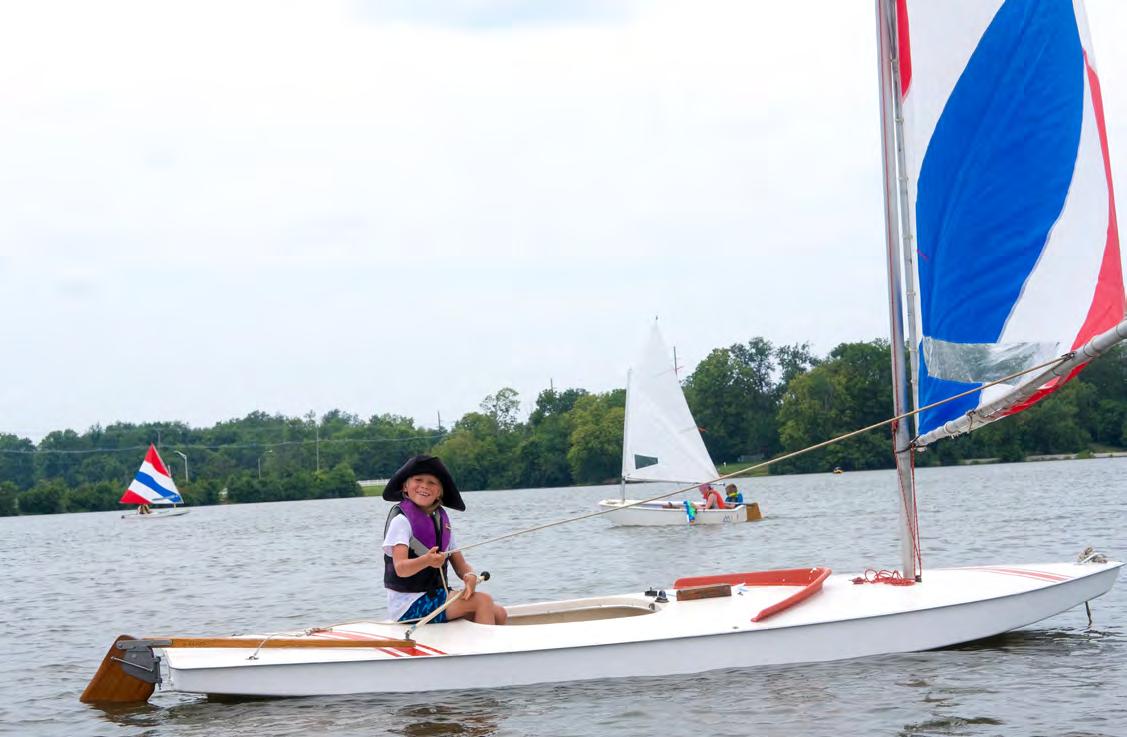
24 The Grandest Reopening A determined businesswoman led the reconstruction of a Letcher County grocery and community hub
28 Showers of Blessing Letcher County’s libraries work to recover from the July 2022 floods with the help of friends, strangers and a best-selling Kentucky author

DEPARTMENTS 2 Kentucky Kwiz 3 Readers Write 4 Mag on the Move 8 Across Kentucky 12 Cooking 45 Kentucky Explorer 56 Past Tense/ Present Tense 58 Field Notes 60 Gardening 62 Calendar 64 Vested Interest 10 Alfresco Affairs A series of suppers at historic sites offers education, entertainment and good food from a Beard-nominated Kentucky chef 16 The Harmony of the Boat A Lexington sailing program teaches campers to work in concert with the elements, their vessels and each other 32 Training Tomorrow’s Headliners The Lexington School for Recording Arts educates students for the music industry 36 Houseboat Heaven
Vance sells a lifestyle along with floating homes 38 Good Food
Good
restaurant survived fire and COVID19 to continue delighting local diners kentuckymonthly.com 1 in this issue 16
Ken
and
Times A London family
12 JUNE • JULY ON THE COVER
the Flood
The Kentucky Trust for Historic Preservation presents the Summer Supper Series
After
kentucky kwiz
Test your knowledge of our beloved Commonwealth. To find out how you fared, see the bottom of Vested Interest.
1. Which Kentuckian said, “I know that I have demons. I don’t know if I want to get rid of them altogether, but I would like to experience them in a different way.”
A. Hunter S. Thompson
B. Johnny Depp
C. Ashley Judd
2. Who penned the original draft of the Kentucky Resolutions of 1798?
A. Isaac Shelby
B. Henry Clay
C. Thomas Jefferson
3. What are the converted measurements of the recreated Noah’s Ark in Grant County?
A. 510 feet long, 51 feet high and 85 feet wide
B. 882 feet long, 85 feet high and 92 feet wide
C. 2.2 million barleycorns long, 100 hands high and 32,000 fingers wide
4. New York Giants pitcher Doc Sechrist, a Williamstown native, played in one game on April 28, 1899. He walked both batters that he faced before being relieved. Neither runner scored, and since he didn’t record an out, he lacks what?
A. A reason for being included in the Kentucky Kwiz
B. A reason for having a historical marker
C. An official earned run average
5. Starting in 1979 as a part-time stock clerk at Kroger while a student at the University of Kentucky, Pineville native Rodney McMullen has been the chief executive officer of the Cincinnati-based company since 2014. The Cincinnati Enquirer reported that McMullen received what total
compensation in 2021?
A. $500,000
B. $1 million
C. $18 million
6. Berea College graduate and songwriter Billy Edd Wheeler, now 90, wrote “Coward of the County” for Kenny Rogers and which Grammy Award-winning song that was sung by Johnny Cash and June Carter and Joaquin Phoenix and Reese Witherspoon?
A. “Ode to the Little Brown Shack Out Back”
B. “Jackson”
C. “Coal Tattoo”
7. Home to the Madrid Bend or Kentucky Bend, Fulton County also is home to which other geographic anomaly?
A. It borders two other states
B. Its largest city is not the county seat
C. It borders only one other Kentucky county
8. Which Kentucky county has the highest Black population by percentage?
A. Christian County
B. Fulton County
C. Jefferson County
9. Which obscure German street game plays its world championship July 23-25 on George Hauck Way in Louisville’s Schnitzelburg neighborhood?
A. Dainty
B. Besenstiel
C. Der Boccia Ball
10. Most distillery barrels hold 53 gallons, which equals how many bottles of bourbon?
A. 106
B. 150
C. 200
Celebrating the best of our Commonwealth
© 2023, Vested Interest Publications
Volume Twenty-Six, Issue 5, June/July 2023
Stephen M. Vest
Publisher + Editor-in-Chief
Editorial
Patricia Ranft Associate Editor

Rebecca Redding Creative Director
Deborah Kohl Kremer Assistant Editor
Ted Sloan Contributing Editor
Cait A. Smith Copy Editor
Senior Kentributors
Jackie Hollenkamp Bentley, Jack Brammer, Bill Ellis, Steve Flairty, Gary Garth, Mick Jeffries, Kim Kobersmith, Brigitte Prather, Walt Reichert, Tracey Teo, Janine Washle and Gary P. West
Business and Circulation
Barbara Kay Vest Business Manager
Jocelyn Roper Circulation Specialist
Advertising
Lindsey Collins Senior Account Executive and Coordinator
Kelley Burchell Account Executive
Teresa Revlett Account Executive
For advertising information, call 888.329.0053 or 502.227.0053
KENTUCKY MONTHLY (ISSN 1542-0507) is published 10 times per year (monthly with combined December/ January and June/July issues) for $25 per year by Vested Interest Publications, Inc., 100 Consumer Lane, Frankfort, KY 40601. Periodicals Postage Paid at Frankfort, KY and at additional mailing offices.
POSTMASTER: Send address changes to KENTUCKY MONTHLY, P.O. Box 559, Frankfort, KY 40602-0559.


Vested Interest Publications: Stephen M. Vest, president; Patricia Ranft, vice president; Barbara Kay Vest, secretary/treasurer. Board of directors: James W. Adams Jr., Dr. Gene Burch, Gregory N. Carnes, Barbara and Pete Chiericozzi, Kellee Dicks, Maj. Jack E. Dixon, Bruce and Peggy Dungan, Mary and Michael Embry, Judy M. Harris, Greg and Carrie Hawkins, Jan and John Higginbotham, Frank Martin, Bill Noel, Michelle Jenson McDonnell, Walter B. Norris, Kasia Pater, Dr. Mary Jo Ratliff, Barry A. Royalty, Randy and Rebecca Sandell, Kendall Carr Shelton and Ted M. Sloan.
Kentucky Monthly invites queries but accepts no responsibility for unsolicited material; submissions will not be returned.
kentuckymonthly.com

2 KENTUCKY MONTHLY JUNE/JULY 2023
Readers Write
Augusta Pride
In Steve Vest’s column, he mentioned the great little town of Augusta (March issue, page 64).
The Augusta Art Guild hosts an event on the first Saturday in June called Art in the Garden. It is a small town, high-quality art show with music, juried local art and lots of hometown pride.

The town also has the White Christmas Parade in honor of the late Rosemary Clooney, who lived in Augusta, on the second Saturday of December. It is full of fun and cheer. Both are worth coming to see and participate in. Thanks for your wonderful magazine! I love the Kentucky Kwiz, the regular columns and your featured articles rarely fail to inspire me.
And I have to chime in on the E or e debate! I definitely think Eastern Kentucky is correct.
Appreciation for Ada
I enjoy every issue but was particularly delighted with the February issue, whose cover featured Ada Limón, the United States Poet Laureate.
It’s hard to believe, but some people think Kentucky is rife with illiterates! It’s been a while since that issue, but I wanted you to know that Limón was featured in an episode of The Good Doctor. In Season 6, episode 18, entitled “A Blip,” a patient’s memory loss from Long COVID led her to short bursts of joy from poetry rather than the long forms of literature.
The poem, which began, “In the greening of the trees,” is from Limón’s volume entitled The Carrying That cover of that book, which was featured on page 14, is bright red and is on the patient’s lap, athough she knows the poem by heart. Her recitation is at the end of the episode.
A Gratifying Read
I thoroughly enjoyed Kristy Robinson Horine’s story about author Georgia Green Stamper. (April issue, page 36). “The Bard of Natlee” was totally engaging, with a use of language that really pulled the reader into a thought-provoking story about our sense of place.
Two paragraphs in Horine’s feature story were especially enriching to this longtime reader and community newspaper reporter. “Place,” Horine writes, “has a way of rounding edges and creating new ones. Place defines, refines, shapes, grows, stunts and sustains us. Place connects people and stories.”
I agreed with Horine’s last sentence: “It’s a win for little old places like Natlee and for every story just waiting to be told.”
Thanks for stories like this one about interesting folks who have a place in Kentucky that they call home.
The Kentucky Gift Guide
 Barbara
Barbara
Morgan, Bracken County
Carol
Ann Morrow, Union
Bob Vlach, Georgetown
We Love to Hear from You! Kentucky Monthly welcomes letters from all readers. Email us your comments at editor@kentuckymonthly.com, send a letter through our website at kentuckymonthly.com, or message us on Facebook. Letters may be edited for clarification and brevity.
UNITING KENTUCKIANS EVERYWHERE.
Counties mentioned in this issue... kentuckymonthly.com 3
Find more at kentuckymonthly.com. Use your phone to scan this QR code and visit our website. Follow us @kymonthly This handy guide to sipping in the Bluegrass State spotlights local breweries, wineries and, of course, distilleries. Discover unique ways to drink in Kentucky, creative cocktail recipes and more.
Kentucky Monthly’s annual gift guide highlights some of the finest handcrafted gifts and treats our Commonwealth has to offer.
Drink Local
WKU Public Radio
is a regional network of four radio stations, with studios and offices on the Western Kentucky University campus.

WKYU-FM 88.9, Bowling Green
WDCL-FM 89.7, Somerset
WKPB-FM 89.5, Henderson/Owensboro

WKUE-FM 90.9, Elizabethtown
plus live webstreaming at wkyufm.org
MAG ON THE MOVE
Even when you’re far away, you can take the spirit of your Kentucky home with you. And when you do, we want to see it!
Liberty Hall, Frankfort
WKU PBS
WKYU 24-1
broadcasts on Channel 24 to a population of over 250,000 citizens of Kentucky and is carried on over 20 cable systems throughout southcentral Kentucky.
Donate to WKU PBS to stream Channel 24 anytime, anywhere!
wkyufm.org/donate
Louisville’s Leslie Miller and Julien Icher, founder and president of the Lafayette Trail, visited Frankfort’s Liberty Hall as part of an ongoing commemoration of the Marquis de Lafayette’s “Grand Tour of the United States” from 1824-25. The general was pivotal to the Colonists’ victory in the Revolutionary War. Icher’s group will next place a marker in Shelbyville, possibly in September.

travel
4 KENTUCKY MONTHLY JUNE/JULY 2023
Cruise
PADUCAH Belle Louise Historic Guest House
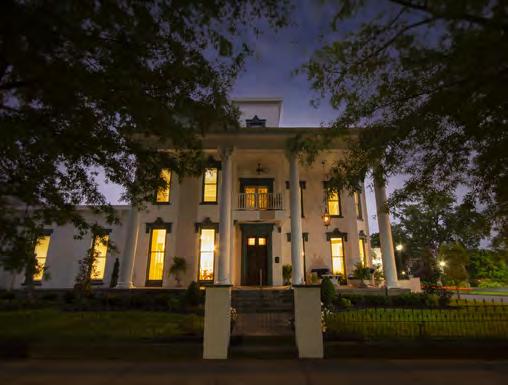
Ron and Jeanie Sanders of Madisonville enjoyed reading their Kentucky Monthly magazine during their Christmas cruise on the Panama Canal. They had a pleasant day with temperatures in the 80s, while friends and family back home celebrated the holiday with a -20 degree windchill.
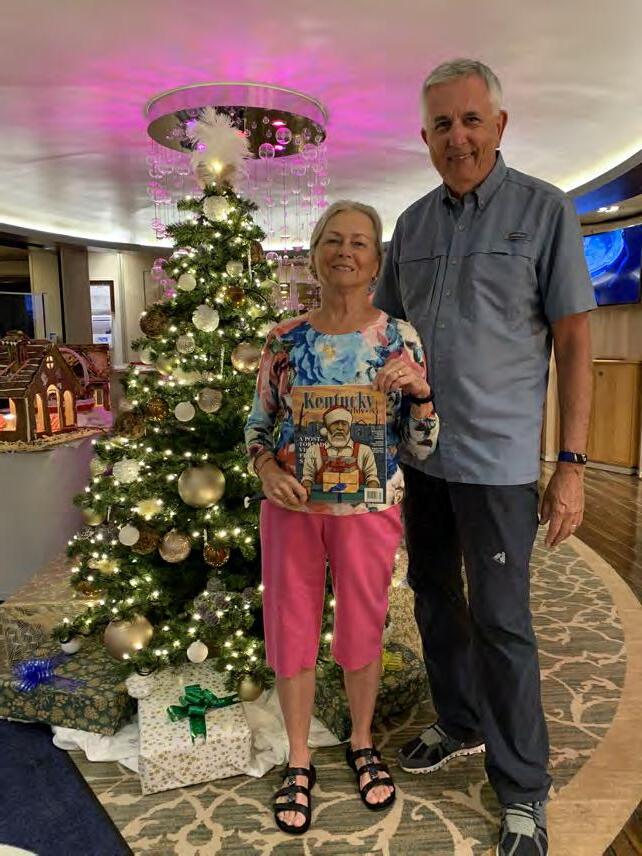
Strasbourg, France
Hanson residents Terry and Sarah Spencer enjoyed the sights in Strasbourg, France.

Belle Louise
House is in one of Paducah’s oldest neighborhoods. Conveniently located just a few blocks from the National Quilt Museum, the Greenway Trail, the Riverfront and Paducah’s commercial historic district which enhances your visit with unique boutiques, craft breweries, premier dining choices, art galleries and entertainment.
270.210.2553 • bellelouisepaducah.com
LA GRANGE
Pillow and Paddock
502.222.4372
pillowandpaddock.com
The Pillow and Paddock Bed & Breakfast is a casually elegant country inn featuring beautifully appointed Luxury Suites, situated in the heart of Oldham County.


kentucky b&b
LA GRANGE Bluegrass Country Estate
502.222.2009
bluegrasscountryestate.com
BARDSTOWN
Bourbon Manor 502.350.1010 • bourbon.com
BURLINGTON
Burlington’s Willis Graves Inn
859.689.5096 • willisgraves.com
PARK CITY Grand Victorian Inn
270.590.1935 • grandvictorianinnky.com
LOUISVILLE Inn at Woodhaven 502.895.1011 • innatwoodhaven.com
SPRINGFIELD Maple Hill Manor
859.336.3075 • maplehillmanor.com
WARSAW Riverside Inn 859.567.1399 • riversideinnbb.com
LIVERMORE River Trails Inn

airbnb.com/rooms/38361408
IRVINE Snug Hollow Farm
606.723.4786 • snughollow.com
SONORA Thurman Landing
270.949.1897 • thurmanlanding.com
kentuckymonthly.com 5 SPECIAL ADVERTISING SECTION
plan
staycation
Panama
recommendations
a
The
Guest
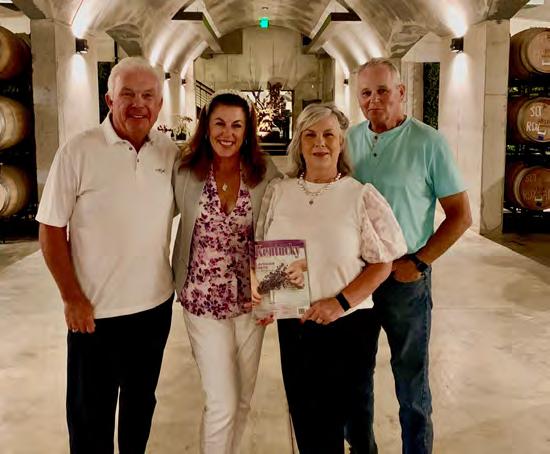

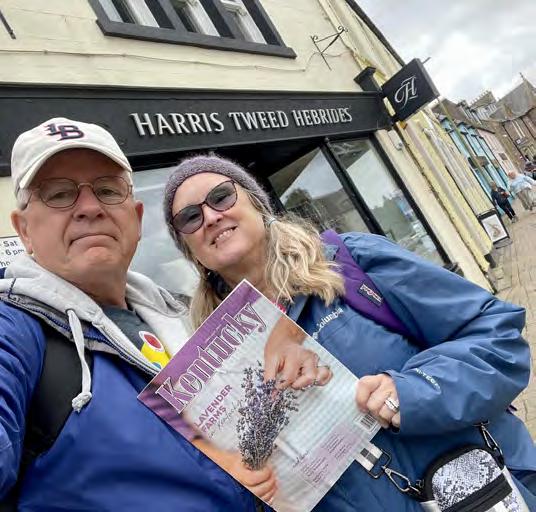


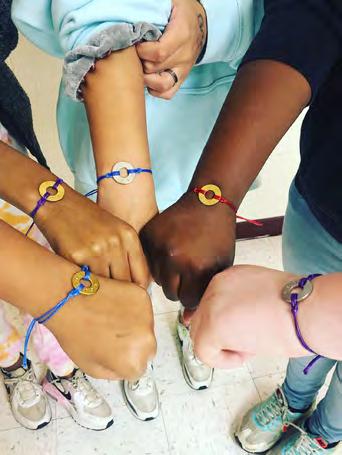


6 KENTUCKY MONTHLY JUNE/JULY 2023 Email a high-resolution photo, along with a caption, to editor@ kentuckymonthly.com SUBMIT A PHOTO Texas travel
LaAnna Mraz of Elizabethtown stopped to browse at the Harris
shop in Stornoway, Scotland, in
Islands.
$5 OFF of Goat Cheese sampling www.bakerbirdwinerydistillery.com Visit website to make reservations WINE & GOAT CHEESE PAIRING at Baker- Bird Winery & Distillery wjrfoundation.org educate connect prevent breaking cycles with Kentucky’s kids
Gary and Sheila Arthur of San Antonio and Mark and Jennifer Arthur Owens of Owensboro enjoyed a wine tasting at Slate Theory Winery in Fredericksburg, Texas.
Jerry and
Tweed
the Outer Hebrides
Scotland
NUMBER ONE SOURCE CARVINGS by KENTUCKY LEGEND MINNIE ADKIN S and 50 More FOLK ARTISTS ——————————POSSUM COUNTY ™ FOLK ART ON LINE ONLY Since 2004 www. PossumCounty .net
wanda joyce robinson
foundation



239.275.1717 Call for pricing & booking Cruise to Alaska celebrate our 25 th anniversary with us CRUISE INCLUSIONS 7-NIGHT CRUISE ACCOMMODATIONS MEALS ENTERTAINMENT EXCLUSIVE AMENITIES DRINK PACKAGE PRE-PAID GRATUITIES WIFI PACKAGE PRIVATE EVENTS FOR KENTUCKY MONTHLY GROUP May 2024 CRUISE EVERYTHING 239.275.1717 CALL TO BOOK kentucky monthly invites you on a cruise to alaska!
Blue Run Spirits to Open in Georgetown
Georgetown soon will be the new home of Blue Run Spirits’ headquarters and distillery. The 35,000-square-foot facility and 20,000-square-foot rickhouse are projected to open in 2025, bringing more than 45 full-time jobs to the region.
Mike Montgomery, Blue Run Spirits CEO and cofounder, said the new buildings will provide a welcoming, unexpected and modern facility with a focus on sustainability. “Design is at the center of everything we do at Blue Run—from our liquid to our bottle to our new distillery,” he said. “The design [the Bjarke Ingels Group] has developed is in dialogue with the landscape, the meandering path to making whiskey, and a manifestation of the bold, distinct and inviting ethos that signifies Blue Run Spirits.”

More information can be found at bluerunspirits.com.
Bourbon-Lovers’ Raffle
Close your eyes and imagine winning more than 200 bottles of a single-barrel bourbon—at one time. Now open them because it’s become a possibility thanks to Educational Justice’s Kentucky Bourbon Raffle.
For $100 a ticket, entrants have a chance to win the grand prize of an entire barrel of bourbon from Whiskey Thief Distilling Company. The drawing will be June 23.
The winner will select the barrel among those resting at Whiskey Thief, tasting the various flavors in a private-selection experience with Whiskey Thief’s distilling team. A barrel of bourbon generally yields 200-225 750-milliliter bottles of bourbon and has a retail value of $9,000-$15,000.
The money raised will help Educational Justice’s mission to end educational inequity.
For more information and to purchase raffle tickets, visit kentuckybourbonraffle.org
Ingram Expansion
The town of Columbus in Hickman County just got a lot bigger thanks to Brown Water Spirits LLC. The makers of the O.H. Ingram River Aged have moved operations to a larger facility in the town.
“Wickliffe [Ballard County] was an amazing place to begin our journey,” said founder Hank Ingram. “Since launching in the fall of 2020, we’ve seen remarkable growth. Expanding operations and moving to a larger location are necessary steps.”
Columbus is beside the Mississippi River, a necessity for the unique way Ingram River Aged whiskey is aged: in floating barrelhouses. Barrels spend their years exposed to the climate and constant motion of the Mississippi River. That motion ensures that the whiskey never stops working, creating what the company calls “Mellowed on the Mississippi.”
For more information on Ingram River Aged, visit ingramwhiskey.com.
5 Joe Bennett (1982), Elizabethtown-born co-host of the Eric and Joe Show
6 Phillip Allen Sharp (1944), Falmouth-born Nobel Prizewinning geneticist and biologist
6 Darrell Griffith (1958), also known as “Dr. Dunkenstein,” who led the University of Louisville to the 1980 NCAA Championship
8 Sturgill Simpson (1978), country music singer-songwriter from Jackson
9 Johnny Depp (1963), Owensboro-born actor, who in 2012 was the world’s highest-paid star
9 Jacqueline Coleman (1982) 58th lieutenant governor from Harrodsburg
11 Frank X Walker (1961) Kentucky’s poet laureate for 2013-2014
30 Desi Lydic (1981), comedic actress from Louisville, best known as a correspondent on The Daily Show
JULY
8 Joan Osborne (1962), Grammy-award-winning singersongwriter from Anchorage
9 Linda Bruckheimer (1945), author-editor and philanthropist from Bloomfield
21 Chrishell Stause (1981), Marshall County actress best known for Netflix’s Selling Sunset
22 Gurney Norman (1937), Kentucky’s poet laureate for 2009-2010
24 Crystal Wilkinson (1962), a founding member of Affrilachian Poets, writer-inresidence at Morehead State University
28 Sara Stewart Holland (1981), co-host of the podcast Pantsuit Politics
31 Brien Lewis (1967), president of Transylvania University
across kentucky 8 KENTUCKY MONTHLY JUNE/JULY 2023 JUNE
birthdays
BAD BRANCH FALLS
Access: 2.5 mile trail
In
FLAT LICK FALLS
Access: .6 mile trail
Explore
COPPERAS FALLS



Access: 3.5 mile trail
DOG SLAUGHTER FALLS
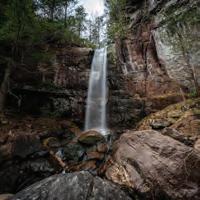
Access: 2.4 mile trail
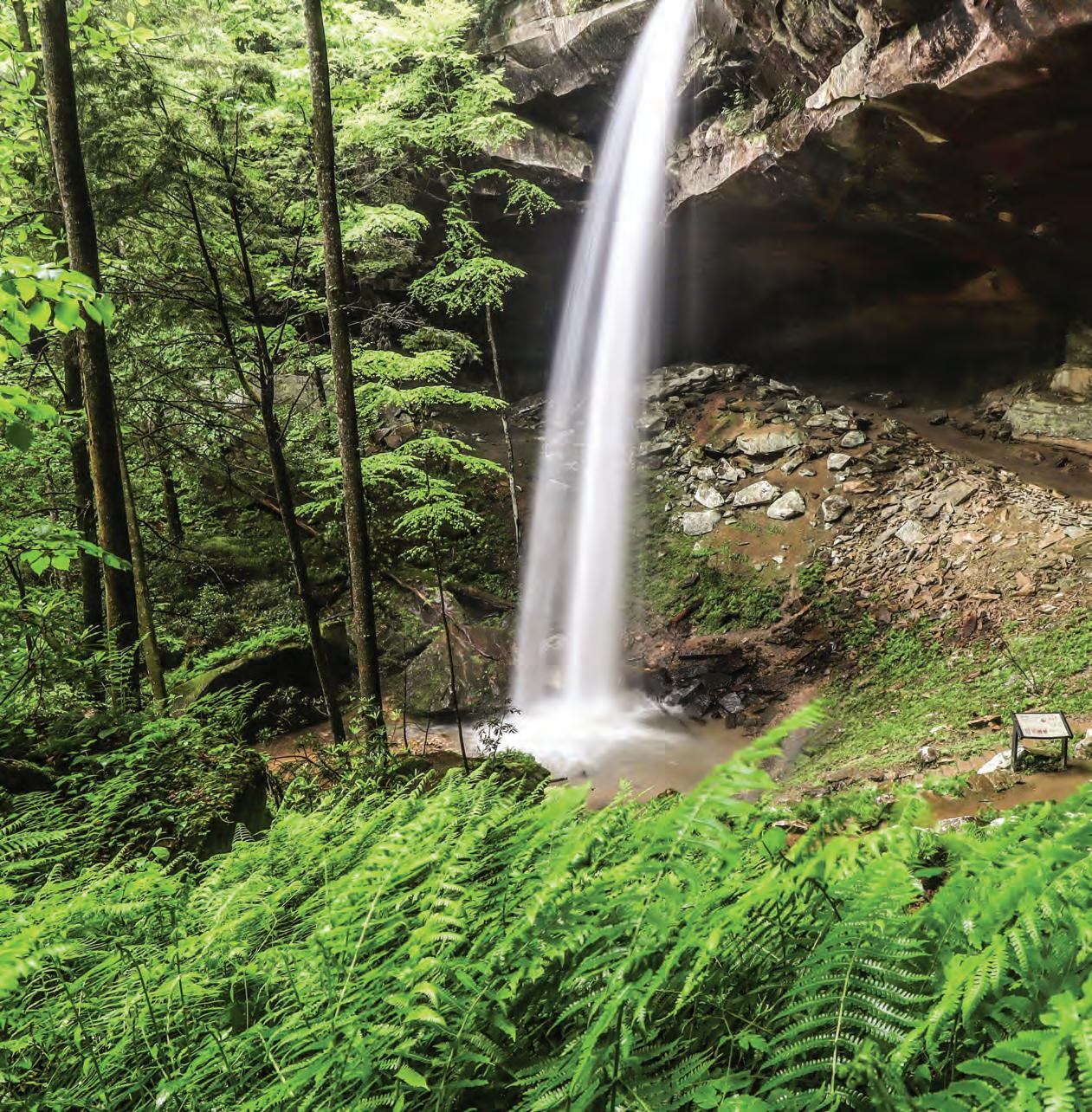
This material is based upon work supported under a grant by the Appalachian Regional Commission. Any opinions, findings and conclusions or recommendations expressed in the material are solely the responsibility of the authors and do not necessarily represent the official views of the Appalachian Regional Commission.
All the Falls on The Kentucky Wildlands Waterfall Trail: exploreKYwildlands.com or scan
Photo: Dustin Robinson
The Kentucky Wildlands, you’ll find many paths that lead
ancient
and over mountains
you with
such as the ones on The Kentucky Wildlands
Trail.
through pristine
forests
rewarding
spectacular natural wonders,
Waterfall
YAHOO FALLS
Photo: Micah Smith
Photo: Steve Poynter
Photo: Dustin Robinson
Photo: Rodney Hendrickson
Not all precious gems are made of minerals.
Alfresco Affairs
A series of suppers at historic sites offers education, entertainment and good food from a Beard-nominated Kentucky chef
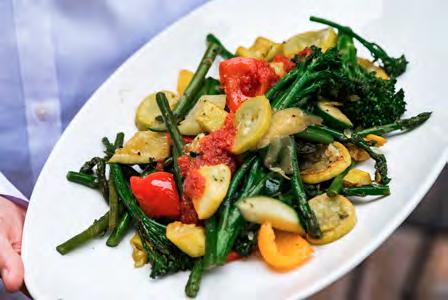

What’s better than dining under the stars with good friends? How about enjoying an outdoor dinner that features farm-to-table seasonal cuisine provided by a renowned chef at a historic Kentucky site, while learning the history of that property? That’s what the Kentucky Trust for Historic Preservation has in store with its Summer Supper Series—interesting, educational gettogethers accompanied by gourmet meals. As a bonus, these experiences benefit the Trust, which is dedicated to preserving, protecting and promoting Kentucky’s historic places.
For the third year, the Trust will
offer the suppers at multiple historic locations across the Commonwealth. Each event will begin with a cocktail hour preceding a catered dinner. Guests will learn about the history and future of the site and enjoy a musical accompaniment. Spark Community Café of Versailles, a nonprofit restaurant dedicated to helping combat food insecurity, is this year’s dining collaborator. Chef Isaiah Sparks, a 2023 James Beard Award nominee, and his team will cater the meals.
The Trust is Kentucky’s first statewide organization dedicated to preservation. It assists the owners of historic properties and helps find
new stewards for other locations. The Trust holds easements and covenants to protect historic places in perpetuity and, in addition to the Supper Series, presents educational experiences such as hands-on workshops and seminars to promote preservation.
This year, the Supper Series will visit Riverside, the Farnsley-Moremen Landing in Louisville; Richmond’s Lynwood Estate; and the restored architecturally intriguing Castle & Key Distillery in Woodford County.
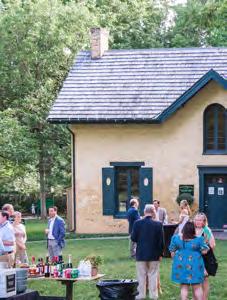
For more information and the upcoming dates of the Summer Suppers, visit kthp.org
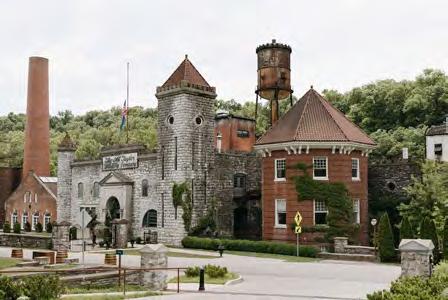
10 KENTUCKY MONTHLY JUNE/JULY 2023
ShelbyKY is the perfect Kentucky getaway. Home to two distilleries, dozens of lodging options, one-of-a-kind dining, and fun-filled outdoor recreation, there’s no shortage of adventure to find in Shelbyville, Simpsonville, and Shelby County.
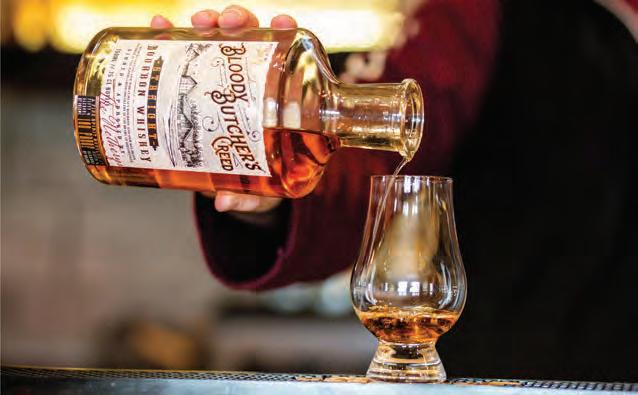

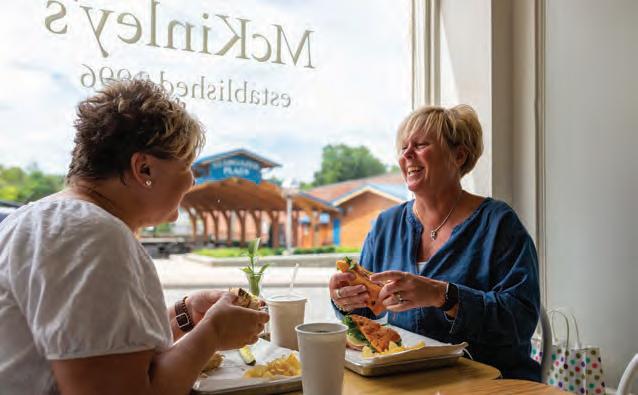
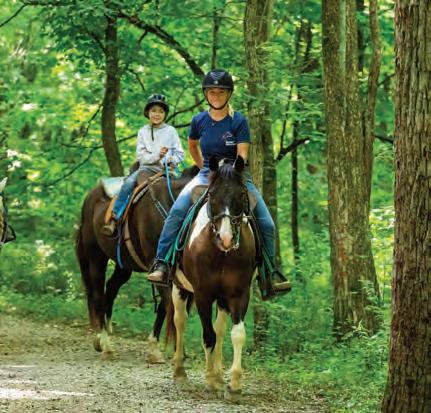
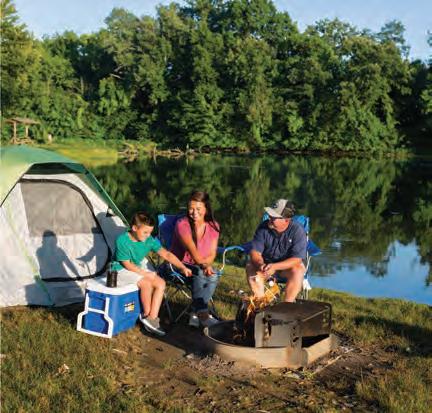
Start planning at visitshelbyky.com.

Squeeze the Day
HENDRIX-INMAN
LemonCoconut Bars
YIELDS 2½ DOZEN
1 cup butter
1 cup sugar
1 egg
1 lemon, juiced
¼ teaspoon lemon extract
2½ cups flour
½ teaspoon salt
½ teaspoon baking soda
1¾ cups flaked coconut
Maraschino cherries
1. Cream butter and sugar. Add egg, lemon juice and lemon extract, beating well.
2. In another bowl, stir together flour, salt and baking soda. Add to creamed mixture, mixing well.
3. Shape batter into 1-inch balls. Roll each ball in coconut. Place on ungreased cookie sheet. Flatten each ball with palm of hand or bottom of jar. Place a cherry in center of each cookie.
4. Bake at 375 degrees for 10 minutes. Immediately slide off cookie sheet to rack to cool.

12 KENTUCKY MONTHLY JUNE/JULY 2023 cooking
PHOTOS BY JESSE
ELAINE COOK • 1982
At one time, Louisville’s Courier-Journal —as well as many other newspapers— published a food section that included recipes. With the advent of other forms of media and the shrinking of daily newspapers, this practice was discontinued.
In 2021, Sullivan University in Louisville received the CourierJournal ’s archived recipes (see story on page 47). This month, we offer a tasty, refreshing selection of lemon-based dishes from the 30,000-plus-recipe collection. In future issues, we’ll present a regular feature in our Kentucky Explorer section that includes recipes from the archives. Enjoy!
ELAINE
CORN • 1981
Lemon-Fruit Sangria

SERVES 4
3½ cups dry white wine, chilled ¼ cup sugar
3 lemons, thinly sliced
1 orange, sliced
Small bunches green grapes
1 10-ounce bottle club soda, chilled
1 tray ice cubes
¼ cup cognac or other brandy
1. In a pretty pitcher, combine the wine and sugar. (Chill a few hours if ingredients are not cold. You may want to chill everything before mixing.)
Recipes from the CourierJournal Archives, Sullivan University, and prepared at Sullivan University by Ann Currie.

2. At serving time, add fruit, club soda and ice cubes to the pitcher. Pour in the cognac and watch it cascade round the fruit.
3. The sangria is ready to drink as soon as you finish making it. Note: If you are serving more than four, a double batch is a good idea.
kentuckymonthly.com 13
Clemson House Frozen Lemon Pie

SERVES 8
3 eggs, separated
Graham-cracker crumbs (We used 1 cup.)
Juice of 2 lemons (We used 1/3 cup juice, but more doesn’t hurt.)
Grated lemon rind from 1 lemon
1 cup cream
½ cup sugar
Strawberries, for serving
1. Beat egg yolks until light. Add sugar. Beat in thoroughly and add lemon juice and grated lemon rind.
2. Whip cream and fold into yolk mixture. Beat egg whites and then fold in.
3. Line freezer-safe glass pie dish with graham-cracker crumbs. (We buttered the sides and bottom of the tray and patted the crumbs over the bottom and around the sides, reserving a few crumbs for the topping.) Pour in the filling.
4. Sprinkle remaining graham-cracker crumbs on top. Place in the freezer. Serve with strawberries.
South Seas Salad
SERVES 8
1 3-ounce package lemon gelatin
1 cup boiling water
½ cup pineapple juice
½ cup chutney with liquid, finely chopped
2 tablespoons lemon juice
Dash of salt
1 13½-ounce can crushed pineapple, drained (reserve juice)
1¼ cup nuts, or to taste
1. Dissolve gelatin in boiling water. Add ½ cup pineapple juice to gelatin. Add chutney, lemon juice and salt.
2. Chill until egg-white consistency, then add drained pineapple and nuts. Turn into a 1½-quart mold and chill until firm. Remove from mold.
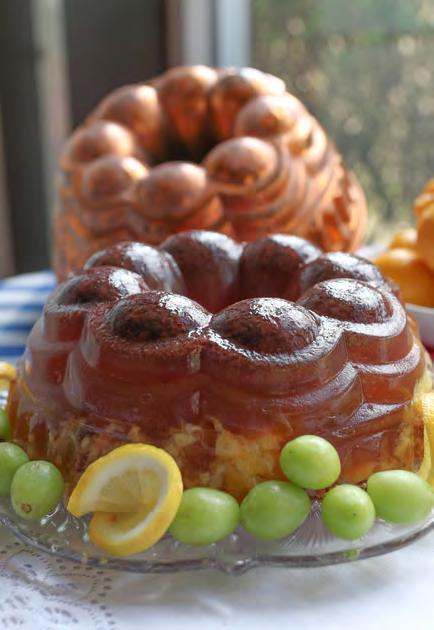
14 KENTUCKY MONTHLY JUNE/JULY 2023 cooking
THE COURIER-JOURNAL SUNDAY MAGAZINE • 1959
LILLIAN MARSHALL • 1973
Frozen Lemon Soufflé

SERVES 8-10
6 egg yolks
1 cup sugar
7½ tablespoons lemon juice
Grated rind (zest or yellow part only) from ½ lemon
6 egg whites
Pinch of salt
1½ cups heavy cream

8 thick slices lemon (seeded)

1 pint strawberries
1. Beat egg yolks with sugar in an electric mixer or by hand until they turn a lighter shade of yellow and fall in ribbons when lifted above the bowl with a spoon.
2. Add lemon juice and grated zest. Beat egg whites with salt until they hold a stiff peak. Fold into the eggyolk mixture.
3. In the same bowl, beat cream until it holds a soft peak. Fold into the egg mixture, mixing it thoroughly.
4. Using a 5- or 6-cup soufflé dish, make a foil collar that stands 2 inches above the rim of the dish. Brush the inside of the collar with vegetable oil. Fasten the collar securely around the dish with string.
5. Spoon soufflé into prepared dish and freeze 8 hours or overnight. Before serving, remove the foil collar and garnish the top of the soufflé with lemon slices that have been twisted into curls.
6. Serve with a bowl of strawberries or make a sauce of the fruit by blending the berries in a processor or blender and add sugar to taste.
kentuckymonthly.com 15
CISSY GREGG • 1988

16 KENTUCKY MONTHLY JUNE/JULY 2023
STORY + PHOTOS BY MICK JEFFRIES
The Harmony of the Boat
A Sailing Association? In Kentucky?
Splish-Splash-Crash! About 50 yards offshore, a teenage girl just capsized her sailboat. She’s bobbing beside it or maybe trying to clamber up on top. It’s hard to tell. A group of parent volunteers are on the shore, but nobody seems too concerned. In fact— was that a giggle?
Righting a capsized sailboat seems like a big job for an adolescent. And the only help coming her way seems to be in the form of good-natured ribbing: “Well, whaddja do that for?” or “What happened?” Or the ultimate teachingmoment catchphrase: “What are you gonna do now?”
This is how Chuck Emrick teaches young sailors about his passion. “It’s magic,” he muses. “There’s no sport out there that you have to take more things in consideration—clouds, rain, wind and waves. You have to interact with nature. You cannot go out there and fight it. You have to find the harmony of the boat—the magic that makes that thing go.”
It’s an aquatic attitude that Emrick and an array of volunteer parents have fostered since the mid-1980s in the Cave Run Sailing Association’s Youth Sailing Summer Program at Lexington’s Jacobson Park.
If you’ve ever wondered about sailing associations, you’re not alone. Clichés abound: The skipper’s cap from Gilligan’s Island. The smug rich guy in a double-breasted blue blazer, toasting with a mimosa in a champagne flute.
Emrick, the program director, seeks to dispel the obsolete myth of sailing as a rich man’s sport. “Back in the ’60s, when you looked at Ted Turner and Dennis Conner … it was elitist,” he concedes. “You had to have a blue blazer and a pair of khaki pants and a rep tie, or you just flat didn’t fit in.”
Emrick, a dentist by day, credits the introduction and mass production of fiberglass boats with bringing sailing to a broader audience. “You don’t have to have a trust fund anymore to find a boat,” he says.
Emrick estimates that an aspiring sailor can buy a decent sailboat for about $500 if you don’t mind putting in some sweat equity doing repairs and maintenance. “That’s how it changed from the blue blazer and khaki pants to shorts, T-shirts and tennis shoes,” he says.
Kentucky has more navigable miles of water than any other state except Alaska, according to the Kentucky Geological Survey conducted by the University of Kentucky. Of those streams, 114 miles have been
kentuckymonthly.com 17
A Lexington sailing program teaches campers to work in concert with the elements, their vessels and each other
designated “Wild Rivers” for their exceptional water quality and aesthetic character.
Much of that water is contained in Kentucky’s 42 manmade lakes. In 1965, the Army Corps of Engineers began creating Cave Run Lake by damming the Licking River near Morehead. After nearly 10 years of work, in 1974, eastern Kentuckians had a new 8,200-acre lake on which to play.
In 1977, individuals and families founded the Cave Run Sailing Association (CRSA) in Lexington. The
organization has grown (“slowly,” says Emrick) in the ensuing decades and now includes about 100 families. The sailing program grew organically out of the CRSA in the early 1980s. The program has been based at Jacobson Park since its inception.

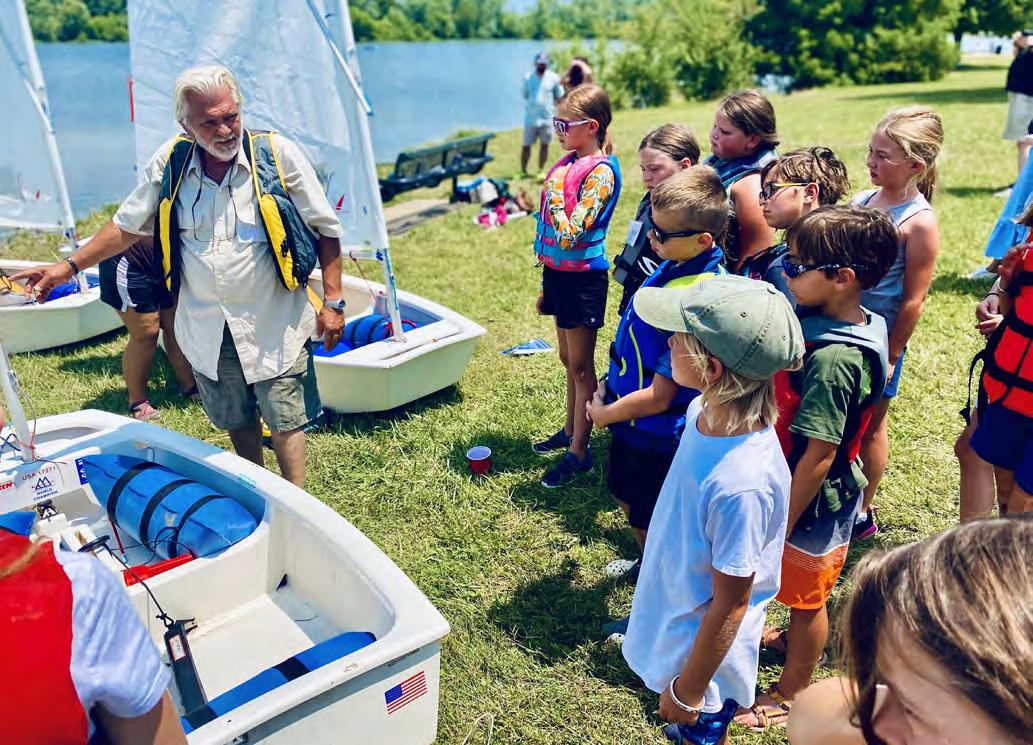
Water, Water Everywhere
“The drink” has long been slang for a body of water, and for the program, the term is somewhat literal, since the program takes place on Reservoir Number 4, an emergency source of drinking water for the KentuckyAmerican Water Company (although the park is now owned by the city). There’s no swimming in Reservoir Number 4. Nonmotorized watercraft are OK, which makes it a decent spot to teach sailing.
On Tuesdays and Saturdays in July, brightly colored sails pop in the breeze, while laughter and happy chatter pepper the humid summer air, both on- and off-shore, as kids between 7-18 learn the basics, including water safety, boat anatomy, rigging, knots, points-of-sail and boat maintenance.
For Emrick and the other volunteers, the program
18 KENTUCKY MONTHLY JUNE/JULY 2023
Chuck Emrick, left, teaches young sailors about his passion.
teaches kids basic values through the thrill of sailing. “You learn a lot about life and leadership—taking charge, being able to take orders, respect for authority, and a little bit of self-reliance,” Emrick says.
It must be working, based on the smiles and looks of concentration on the water at Jacobson Park in July. Many participants share his enthusiasm, as well as the workload: “We try to have a lot of volunteers. Most everybody will pitch in and help out,” Emrick says.
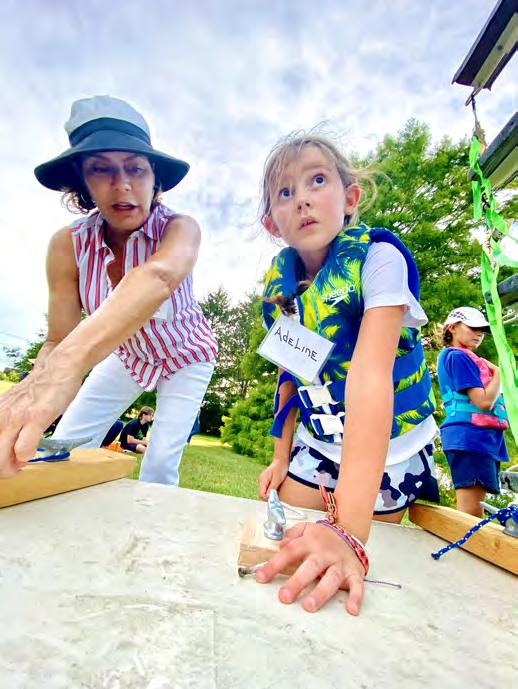
The program strives for a ratio of one volunteer for every two students, not just for instruction, but also for safety. “There’s so much safety in numbers. When you get that many volunteers, there’re a whole lot of eyes on the kids,” he says.
Sometimes, volunteers bring great new ideas. Last year, CRSA member Jen Adler began leading ecology lessons, teaching kids about aquatic ecosystems. “We know kids come to camp to have fun, so we provide active learning games,” explains Adler, a college biology professor by day. “One of our games involves kids pretending to be fish, seeking another group of kids who are pretending to be unpolluted food, water and shelter. Campers come to realize how a minor disturbance can have ripple effects across the ecosystem.”
One of the program’s most amazing features is its economy: $35 for CRSA members, with non-members paying an additional $35 for a summer student membership. That’s a maximum of $70 for six two-hour sailing sessions, with everything provided, including a goody bag for each participant that contains a steel water bottle, sunscreen and more.
Teaching Teamwork
In the Youth Sailing Summer Program, the boats are operated exclusively by the kids without adults on board. With this arrangement, the kids learn more than how to operate a boat, says Emrick. They learn cooperation. “We have two-person boats. One person is the skipper, and one is the crew. We take turns,” he explains. “And when it’s your turn to be the skipper, you can expect your crew to help you—and they better help. We try to teach how to get that point across without yelling at one another.” That’s a core value for Emrick. “I think about half of sailing is just communicating … learning how to work as both a leader and a follower.”
The program uses two types of boats. The younger students (7-12) learn on Optimist sailing dinghies, a beginner craft beloved worldwide in the sailing community. Emrick calls them “the safest, best boat to learn to sail on— very, very forgiving and very stable on the water.”
CRSA members hand built their original set of what they nicknamed the “Opti” in the early ’80s. “We’d build them in the basement in the wintertime and then teach [the students] how to sail them in the summer,” Emrick recalls. These days, they’ve upgraded to a small fleet of manufactured fiberglass Optis.
Teens get to learn on the program’s somewhat sleeker Sunfish sailboats, which were financed by selling off bigger craft that had been donated to CRSA. Sometimes called “the world’s most popular sailboat,” the Sunfish design dates back to the late 1950s.
“Kids love them because you can really get going,”
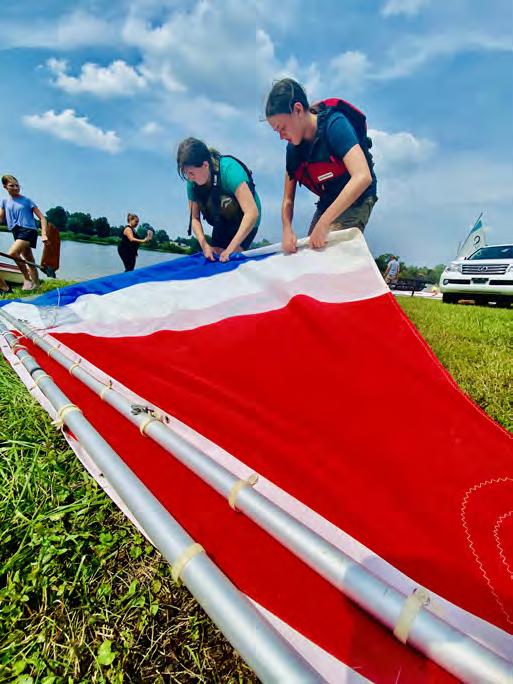
kentuckymonthly.com 19
Emrick explains. “And it’s a wet water boat—you don’t go out on a Sunfish thinking you’re gonna stay dry! Part of the deal is that you turn them upside down, and you gotta right them up.”
Not Just for the kids
In the company of sailboats, grass, water and sun, the enthusiasm at Reservoir Number 4 is infectious— especially once parents see their kids take to the water.
Parent Richard Sanchez was surprised and delighted by the level of parental involvement. “It’s amazing the way the grownups and kids work together,” he says. “My first time there—all of a sudden—I was helping to load boats onto a trailer! The teamwork they promote is really wonderful.”
Shane Tedder, who’s had two children in the program, was charmed from the get-go: “Within minutes of arriving at our first day of sailing camp, Chuck gathered all the students at his feet, pointed out across the lake, and asked:
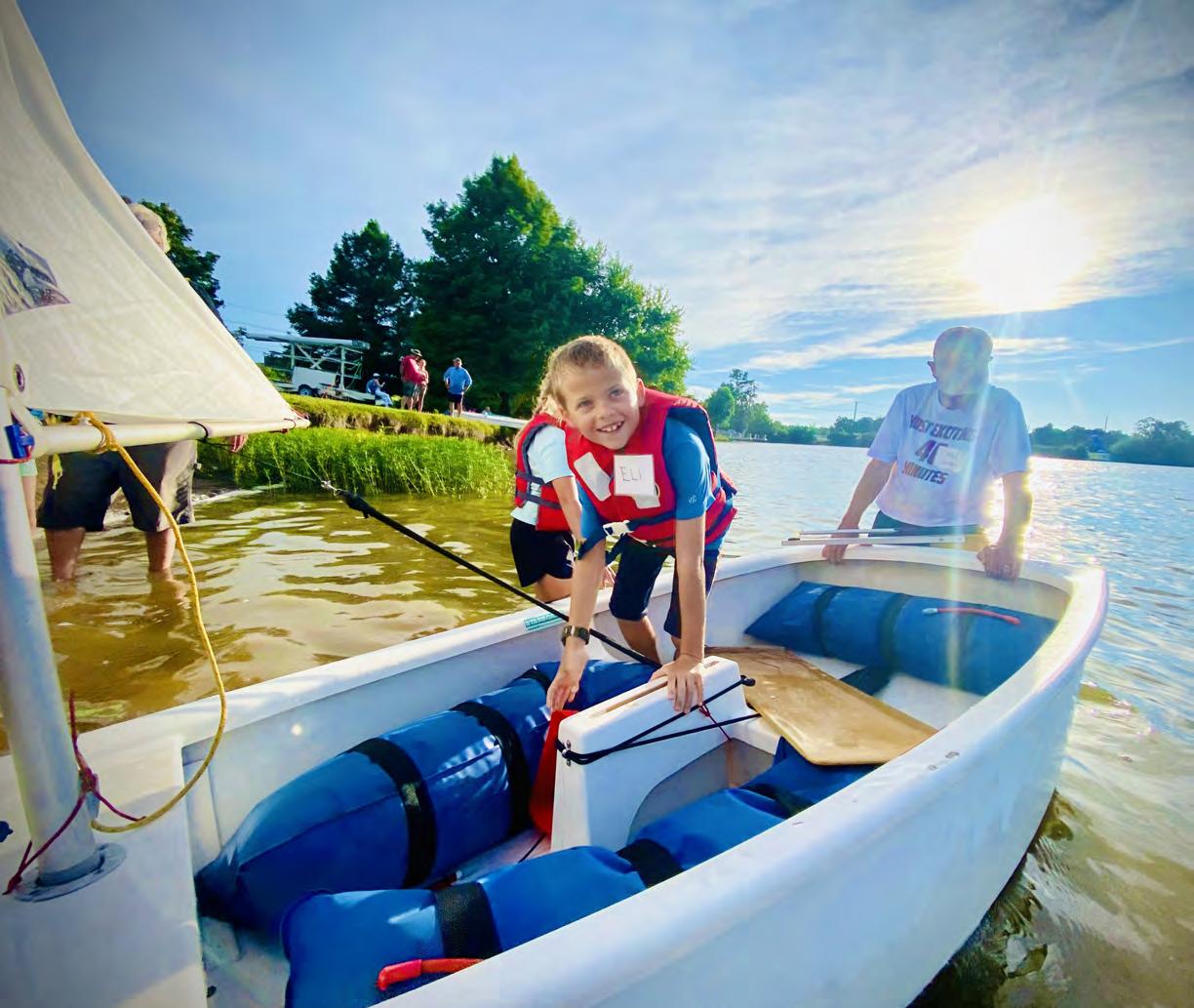
‘What do you see out there?’ Predictable answers—water, birds, trees—were offered by the students. With a gleam in his eye, Chuck responded, ‘I see magic, and it’s a magic that can take you around the world!’ As soon as my wife and I heard that, we knew we were in the right spot.”
“I am amazed at the confidence that the kids gain by navigating their own boat,” Adler says. “Imagine catching the wind with a piece of cloth, setting out across the water, and instinctually understanding how to return to shore. Purely amazing!”
Emrick thinks some of the wonder comes from teaching by good old trial and error. “Sometimes, you fall flat on your face and think, ‘Well, that didn’t work out so well.’ And so, you have to back up and say, ‘All right, let’s think about this differently. How can I come up with something else that would work?’ ”
It’s a kind of learning that doesn’t feel like learning, especially on Pirate Day, the finale of the camp. Pirate Day traditionally includes costumes, water fights and lots of
20 KENTUCKY MONTHLY JUNE/JULY 2023
Learn to Sail
Cave Run Sailing Association’s 2023 Youth Sailing Summer Program



Jacobson Park
4001 Athens-Boonesboro Road, Lexington
Ages 7–18
TUESDAYS
July 11, 18, 25; 6–8PM
SATURDAYS
July 15, 22, 29 ( Pirate Day) ; 1–4PM
COST: $35 for CRSA members. Nonmembers pay an additional $35 for a summer youth membership.
For more details and to register, scan the QR code or visit www.caverunsailing.org.
sailing, of course. “Kids like it because of the squirt guns and water balloons,” Emrick says. “But in the middle of that, they have skills to show us. They don’t realize they’re walking down the aisle for a graduation ceremony. When you watch them getting around on their boats and chasing each other around the buoys? That’s their graduation!”
He hands out diplomas to prove it—hard-won and presented with pride.
Which brings us back to the kid out in the water beside her flipped Sunfish. A couple of the CRSA members putter over to help her in the johnboat that serves as the program’s coaching/safety vessel. Emrick,
always keeping a watchful eye out for challenges and frustrations across the lake of young sailors, coaches her on how to stand on the upended centerboard, which—as if by magic—results in the soggy sail lifting up out of the water. She’s back up and cruising along.
“We try to make it fun, with enough structure to teach a little bit about boat parts and problem-solving,” Emrick says.
“Comes that day that you’ve learned all we can teach out of a book,” Emrick reflects. “Now, it’s time to get out there, put your hand on the tiller, and let’s see how we do! If you’re in sync with the wind, there’s no better feeling.” Q
kentuckymonthly.com 21
“In 2020, learning I had cancer was a shock. As I made the decision about where to receive treatment, I was led to the outstanding treatment facility that was here at home — the Lawson Cancer Center at PMC.



I’m so thankful that I did my treatment here. The quality of care I received was second to none. The doctors, the nurses, the support staff — everyone involved — became family. I don’t feel like I could have gotten the same treatment in a larger city or institution.”
 – Robert Staggs
– Robert Staggs

CANCER can be defeated.

22 KENTUCKY MONTHLY JUNE/JULY 2023
FREE
TODAY, I AM CANCER
pikevillehospital.org | (606) 430-2212
After the Flood
“Resilient.” The word was used repeatedly to describe the people of eastern Kentucky following the devastating flooding of July 2022. National, state and local officials referred to those affected as resilient. Even residents of the area used the term.
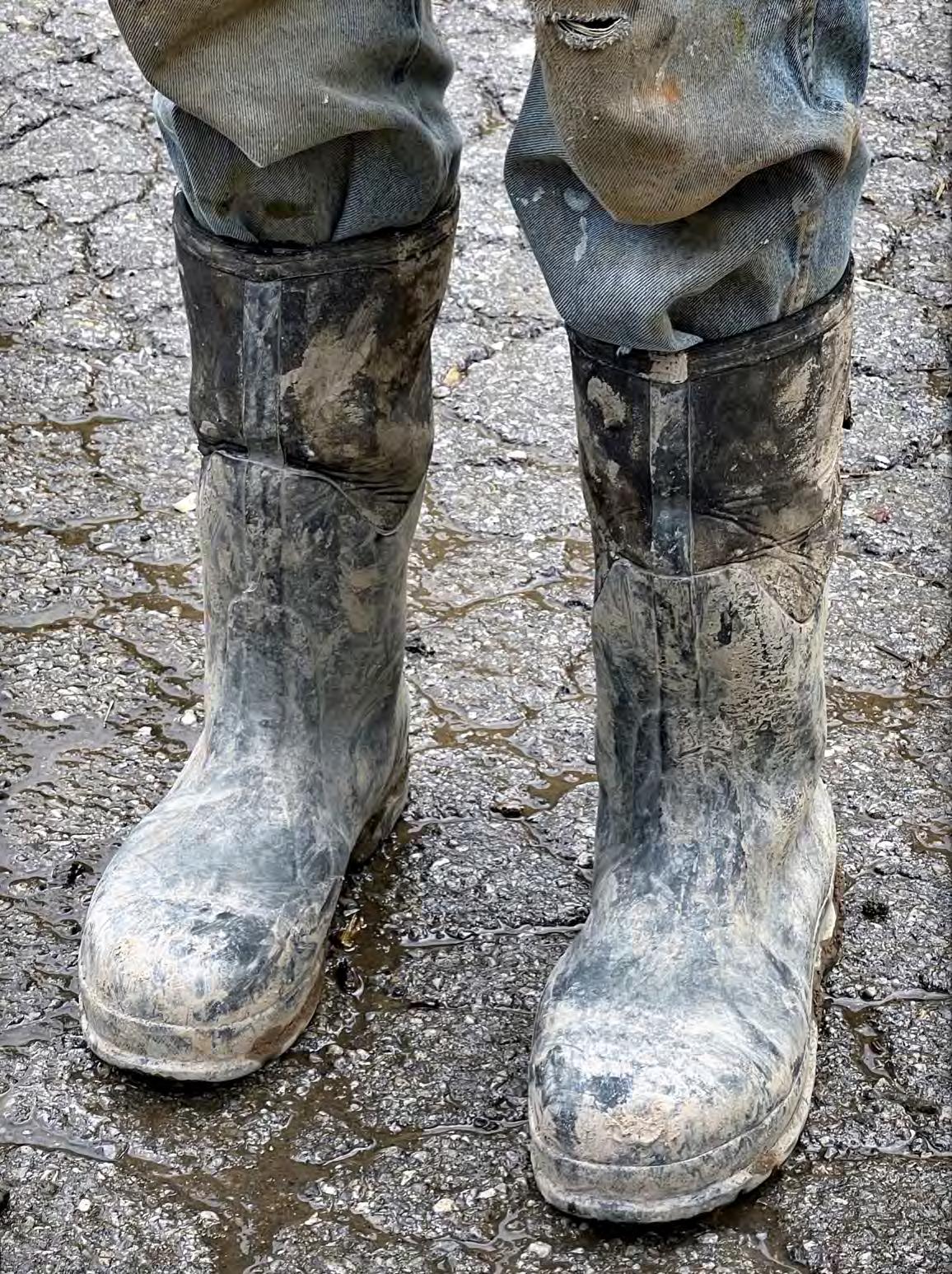
“The people of Appalachia are very resilient, and we will overcome it,” Lakyn Bolen—a resident of Knott County, which was deluged by 14 inches of rain from July 25-29—told Time magazine in August 2022. “I have no doubt in my mind that we’ll just come back better than we were.”
Bolen’s positive attitude was shared by many. Rebuilding and restoration have been ongoing the past 11 months, with the help of thousands of volunteers and government aid. But the recovery is not complete, and assistance is still needed.
On the eve of the one-year anniversary of the flooding, we salute those who have worked tirelessly to clean up and recover from the disaster. We offer contact information for those who would like to help. And we remember the 45 individuals who lost their lives as well as those who lost their homes.
Readers can learn more about the strength and determination of eastern Kentuckians on the following pages in two stories that are profiles of resilience.
kentuckymonthly.com 23
>>>

The Grandest Reopening
On a fine spring day in early April, the Letcher County town of Isom celebrated an almost-miraculous grand reopening eight months after the devastating floods of July 2022. Those gathered for the event honored the entrepreneurship and compassion embodied in Isom IGA owner Gwen Christon and recognized the store as the community hub in the area. The store reopening did not signal the end of the disaster recovery, but it was an important sign of hope and the return of normalcy for the people of eastern Kentucky.
The pastor of Letcher Independent Baptist Church, Rev. Bill Jones, opened the ceremony with prayer. Gwen shared that Rev. Jones has been a rock for her family in this challenging time, despite the fact that their church building was lost in the flood. She said her family’s faith and their church community got them through this tough time.
John Ross, president and CEO of IGA, spoke at the event about the importance of locally owned grocery stores. “The Christons are a case study for what small business owners should be: smart, hard-working, talented and charitable,” he said. “They are doing it for the right reasons and investing in their community.”

The IGA store is located at a key intersection in the county. It stands as an important resource in a potential food desert and as a gathering place for the community. It is the largest private employer in town, with a staff of 32. When the store was inundated with 6 feet of water and mud last July, it was a painful loss not just for the Christon family.
“The response moved me,” said Arthur Christon, Gwen’s husband. “People who lost everything asked what they could do to help us. One thing they kept saying was, ‘Please reopen the store.’ ”
Reopening was not a foregone conclusion. The inventory, shelving and coolers were a total loss, and the building needed extensive renovation. It felt daunting if not impossible. As Gwen began the arduous task of cleaning everything, she realized she could not do it alone. She asked for help. And help came.
Gwen’s first call was to Alan Atwood of MDI, Isom IGA’s wholesale warehouse supplier. He was there the next day, with literal boots (and shovels) on the ground, and helped solicit donations for the rebuilding process. In the coming
kentuckymonthly.com 25
BY KIM KOBERSMITH
A determined businesswoman led the reconstruction of a Letcher County grocery and community hub
The Christon family fittingly pictured on the “Wall of Values”; from left, Arthur, Gwen, Simon and Cheyenne.
weeks, Gwen’s story went around the world—through social media, grocery news outlets, and national television and radio. Support came from a preacher in Lexington, other IGA stores, grants and everyday folks nationwide.

“It is an honor and a privilege to work with this family, as they are good people and good grocers,” Atwood said. “It has been a challenging eight months for Gwen, but once she decided to reopen, she stared adversity in the face and didn’t blink.”
Gwen began working at Isom IGA soon after the store opened in 1973 and purchased it from the previous owners 25 years ago. The grocery business has notoriously tight profit margins, and Gwen’s business savvy, learned on the job, made the store a success. In February, she was recognized as the Woman of the Year by the Women Grocers of America. According to the National Grocers Association website, the award is given annually to a female store owner who shows strong leadership, a passion for the grocery industry, and a commitment to her community.
Gwen downplayed the recognition. “I don’t feel special,” she said. “Anyone who got flooded would do the same thing.”
Simon Christon, Gwen and Arthur’s son, has become an indispensable part of the business in the last couple of years. He smiles when he shares the first place his mother brought him from the hospital after he was born: the Isom IGA. There, friends and neighbors passed the little bundle around as they sat in the deli seating.
The Isom IGA has come an amazingly long way from last July, when it was inundated with 6 feet of water and mud. Eight months later, the town of Isom celebrated the grand reopening of the store.

As Simon grew up, went to college, and earned his MBA, he wasn’t sure if he would go into the grocery business. In 2020, he had a new job in health care all lined up as he looked to spread his wings beyond the family business. Then the pandemic hit, his job fell through, and he took on the responsibility of pivoting the store to offer pick-up service. He has been there ever since.
“I fell in love with it,” he said. “I asked the Lord about my future and realized I love the community and want to carry on the family tradition.”
This family tradition is a vital part of the community. Even while closed, the store served as a community center. Hot meals and food boxes were distributed from the parking lot, and the store’s Facebook page shared resources on preventing mold in flooded structures and accessing emergency grants for artists.
The Christon family brings something special to their business. A community ethos, forged by their Christian faith and their mountain home, permeates the store. When Gwen says everyone who shops there is family, she means it. Her warm welcome and genuine desire to serve are a big part of what brings people back to Isom IGA to shop regularly.
Whether through careful training or contagion, she has transmitted that spirit to her staff. Her employees faithfully came back to work in the reopened store. Michelle Maggard has worked there for 11 years and is in charge of the freezer section. In a conversation at the reopening, she emanated pride in her work and a conviction that the store is special.
26 KENTUCKY MONTHLY JUNE/JULY 2023
• • •
“At Isom IGA, there is love in it. We like to make it look good. Everyone is greeted here, and our people don’t mind to help,” Maggard said. “The Christon family is amazing. Gwen is always there for us. She is the community.”
• • •



The new iteration of the store is bright and welcoming. The design engineer at MDI helped the owners lay out the store in a common-sense way, with chocolate-chip cookies beside the milk refrigerator and orange juice placed at the end of the coffee and cereal aisle.
As Simon steps more fully into a leadership role at the store, he is bringing to fruition some new plans. A community room is under construction, where people will be able to hold meetings, celebrations and other gatherings that will be catered by the store. He plans to spotlight local artists and entrepreneurs to bolster the entire business community. One of the first was Seven North, the company that created the Isom IGA polo shirts for the grand reopening.
Gwen told the members of her community at the celebration that they are the most important thing inside the building, and the renovated store incorporates them in a beautiful way. Images of local people and places hang on the upper walls between the usual grocery banners announcing “Produce” and “Deli.” They are by Kentucky photographer Malcolm Wilson, who started the Humans of Central Appalachia Facebook page with his late wife. The Christons selected the featured pictures from his repository of more than 20,000 photos from all over the region.
The front of the store has a “Wall of Values,” which holds the weekly specials. The photo selected for this wall is of Arthur, Gwen, Simon and Simon’s wife, Cheyenne, in their matching Isom IGA shirts. The play on words may or may not have been intentional. Regardless, the family’s values of humility, commitment and compassion make the Isom IGA a vital and thriving part of the community. Q
kentuckymonthly.com 27 WE BUY, SELL AND TRADE USED MUSICAL INSTRUMENTS AND EQUIPMENT OF ALL BRANDS MUSIC GO ROUND ALSO OFFERS AFFORDABLE REPAIRS, SETUPS, RESTRINGS AND MAINTENANCE. 3640 S. HurstboUrne Pkwy. Louisville KY 40299 • 502-495-2199 musicgoroundlouisvilleky.com WANTS TO BUY YOUR GEAR JOIN US JULY 3 RD FOR OUR FOURTH OF JULY EVENT
Showers of Blessing
Letcher County’s libraries work to recover from the July 2022 floods with the help of friends, strangers and a best-selling Kentucky author
STORY BY TED SLOAN
PHOTOS BY ALLAN DETRICH
Kentucky author Kim Michele Richardson issued a call to action on Feb. 25:
“Librarian Tessa [Caudill] of the destroyed Neon, KY library called to say they’re rebuilding & are finally at the point to receive books,” Richardson posted on Twitter.
The Fleming Neon Public Library was one of countless structures damaged or destroyed in the historic July 2022 floods that crashed through southeastern Kentucky. Donating a few books from our sizable collection in our (high and dry) Lawrenceburg home seemed like an easy lift.
Library director Alita Vogel responded to a message with a description of the types of books they wanted. Armed with that information, my wife, Ronda, and I boxed up a few of our books. We launched a book drive in our church, Bridgeport Christian, west of Frankfort. Kentucky Monthly donated dozens of books, and friends of Ronda’s from her state government days met us in Versailles to give us a couple dozen more.
We collected more than 600 books of all kinds, from children’s books and paperbacks to large-format art books, but mostly hard-cover fiction and nonfiction.
It was a spit in the ocean compared to the library’s needs. But it was something we could do.
We shoehorned the boxes and bags of books into every free space in our SUV, and on a cool, clear, sunny morning in March, we set out for the Harry M. Caudill Memorial Library in downtown Whitesburg, the drop-off point for book donations for the Fleming Neon Public Library and others in the Letcher County Library District.
The three-hour trip on the Mountain Parkway to Ky. 15 to the Letcher County seat was scenic and effortless. As we got closer to our destination, we encountered evidence of the disaster. Dead vegetation. Smashed structures. A sign that marks where a business used to be.
The aging structure that houses the Caudill Library belies the modern library inside. Visitors are met by a lifesize cardboard cutout of Dolly Parton. Wood carvings by local artisan Venson Caudill are enshrined in a glass case. A cutout of Yoda decorates another section.
All through the open expanse are, of course, thousands of books as well as magazines, DVDs, graphic novels and other media, along with public computers. Tables in the front section are covered with books free for the taking.
Boxes of books almost head high and several rows deep are piled inside the front window. The library staff will catalog those books that will be kept for the libraries and give away the rest.
The library staff on duty that day—Vogel, Susan Adams and Scarlett Stewart—helped unpack our vehicle, adding the boxes to the pile at the front of the library. We took a few pictures, and then Vogel talked about their journey since the July 2022 disaster.
On July 25-30, 2022, up to 16 inches of rain drenched a narrow path of southeastern Kentucky, the National Weather Service website states. Rivers and creeks throughout the region breached their banks; the North Fork of the Kentucky River at Whitesburg swelled in excess of 21
Harry M. Caudill Memorial Library
20 Main Street
Whitesburg, KY 41858
gofundme.com/f/letcher-co-publiclibraries-damaged-by-ky-flood
28 KENTUCKY MONTHLY JUNE/JULY 2023
• • •
money
to the Letcher
District:
To donate books or
directly
County Library
GOFUNDME
LIST OF RESOURCES
SUPPORT
governor.ky.gov/FloodResources
feet above flood stage, obliterating the 65-year-old record of 14.7 feet. Most of the rain fell July 27-28, causing a majority of the flooding and ensuing damage. The governor’s office said the torrential rains and flooding resulted in 45 deaths in the region.
Vogel said three of the four libraries in the Letcher County district were hit by the floods. Fleming Neon took the worst of it. She had to stop to wipe away tears and compose herself before talking about the Fleming Neon library—“It happens every time I talk about this, what happened and how we’re recovering,” she said.
Apparently, Vogel said, the raging flood waters carried a small tree stump through the back door and rushed through the building, carrying furniture, shelves, books and everything else in their path to a café in the front of the structure, where they pushed out a window casing.
The library was inundated with 5 feet of flood water. “It pretty much destroyed everything,” Vogel said, including nearly all of the books and DVDs as well as 10 new computers intended for public use, three of which had been set up. A volunteer saved some books and DVDs that were on the top shelves.

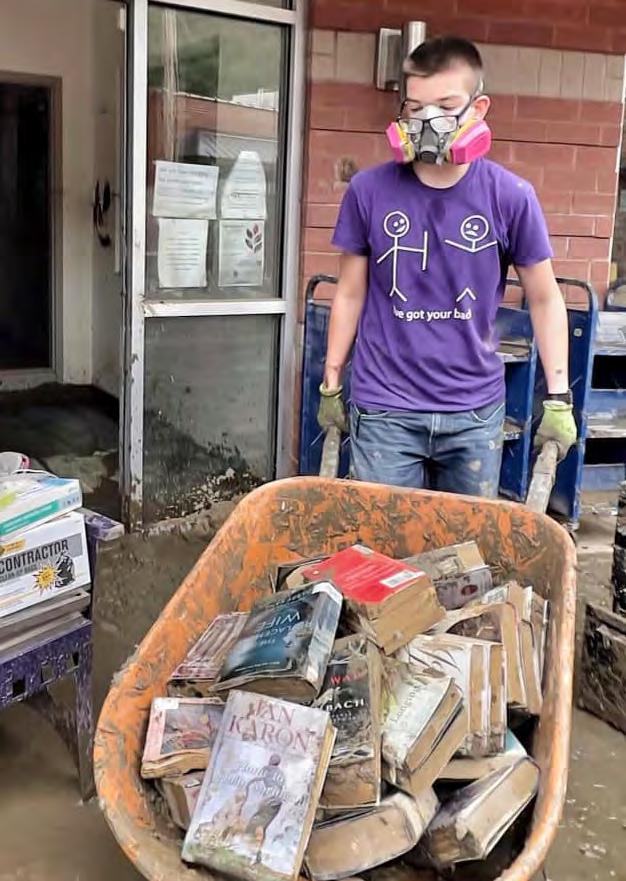
The Blackey library took in 2 feet of flood water, causing damaged flooring, drywall and shelving as well as mold, Vogel said. “We knew flooding in the past, but it
hadn’t gotten up into the building before, not like this,” Vogel said. Volunteers and staff salvaged some of the books, and contractors removed shelving and drywall. Vogel said they plan to “make some changes that I hope will make it a better library,” such as accessibility for people with physical challenges, more seating in the lower level, and a book drop in the front of the building.
The Harry M. Caudill Memorial Library sustained damage to its 50-year-old elevator when water flooded the basement. Odds and ends such as Christmas decorations and books that were intended to be given away were lost, but the library otherwise suffered little damage. “[The Whitesburg library is] so far out of the flood plain, we didn’t think we needed flood insurance,” Vogel said. “It’s like that all over Letcher County.”
The library in Jenkins emerged unscathed, “which is
kentuckymonthly.com 29
amazing because Jenkins [the town] floods at the drop of a hat,” Vogel said.
The library district also lost its bookmobile, which was covered by flood water up to the engine block.
“Needless to say, the last seven months around here have been kinda crazy,” Vogel said.
As we spoke, a library patron stopped to chat with Vogel. “I’m looking for free books again,” the patron said as she carried a plastic bag of books.
“We’ve got boxes. You should take more,” Vogel said.
“Last time, I had four bags,” the patron laughed.
After the flood waters receded, staff members and volunteers, including a disaster recovery group from North Carolina, set about the arduous task of cleaning the libraries. Workers wore rubber boots, gloves and respirators to protect themselves from mold and filth in the midsummer heat.

The Fleming Neon branch was covered by flood insurance, and the library district applied for grants to replace the public computers at Fleming Neon and Blackey and acquire educational computers for children. It is
working with the Federal Emergency Management Agency for funding to modernize and restore the elevator in the Whitesburg library.
Vogel said Toyota on Nicholasville sold a van to the library district at a discount in November. The purchase was “the first thing that we were able to do that really felt like recovery,” Vogel said.
Vogel and her staff use the van for outreach to the libraries scattered throughout Letcher County and for trips to conferences and continuing-education opportunities. “Someday, we might get another bookmobile, but I think an outreach vehicle is serving our needs very well right now,” she said.
Richardson, author of The New York Times bestsellers The Book Woman of Troublesome Creek and The Book Woman’s Daughter, has been a key ally in the libraries’ recovery effort. Richardson has ties to eastern Kentucky, and she learned of the libraries’ plight from the librarians there. Richardson first alerted her social media followers in August, shortly after the floods, and has posted numerous updates, including the Feb. 25 tweet. She also launched a drive to restock the libraries in the Letcher County public schools that were flooded.
Richardson launched a GoFundMe campaign for the library district that exceeded its $30,000 goal and will remain open until July 28—the one-year anniversary of the flood.

30 KENTUCKY MONTHLY JUNE/JULY 2023
• • •
Left, Fleming Neon Library Director Alita Vogel (right) and Librarian Tessa Caudill got more than their hands dirty in the cleanup operation; above, Vogel on a drier, happier day; opposite page, the rushing floodwaters destroyed everything in their path.
Ted Sloan photo
In an email, Richardson remembered posting her call to action and then peeking at the comments the next day “like the person sneaking back into an after-brawl to retrieve their one lost shoe.” Predictably for social media, the responses were mixed: Many were positive and compassionate, but others “were hateful and ignorant to our people,” she wrote.
“But then, immediately, large book donations and money started pouring in, and I thought: In all the division, hate, disagreements and differences in our world, the written word can truly unite us. And I fell in love with humankind all over again.”
Richardson pointed out that libraries are vital resources for eastern Kentucky residents. “Libraries have always been a normalcy for these people and have been a vital safe haven, a refuge,” she wrote. “And librarians are surely like Swiss Army knives. Our librarians are the peacekeepers, social workers, babysitters, resource officers, caregivers and more to so many struggling in life. They are the literacy soldiers and lifelines here and across the U.S.”
Richardson “has been a wonderful friend and support system to us,” Vogel said.
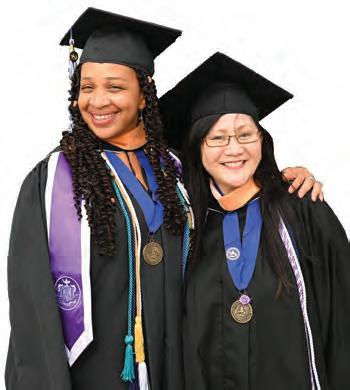
Vogel said the library district aims to reopen the Blackey library by the end of July and the Fleming Neon library by the end of September. She said they will hold a grand reopening for both. She expressed heartfelt thanks to staff, volunteers, donors and “people who have prayed for us.”
By late April, the library district had received some 15,000 books, Vogel said. Books that meet the district’s needs will be shelved in the libraries; others will be given away. Vogel said the library district received more than 4,000 books from the International Book Project, a Lexington-based nonprofit that has donated more than 7 million books to 167 countries since its founding in 1966. Richardson said her literary friends on the coasts and readers across the country made donations to help the cause.
“It truly makes me tear up seeing all these kind hearts and outpouring of love for our beloved Kentucky, a place often misunderstood, and her people often criticized and stereotyped,” Richardson wrote. “I am forever grateful for the kindness and generosity and good wishes that others have shown to Kentucky.” Q

Creating a Culture of Impact
kentuckymonthly.com 31
Educating Nursing Leaders to Have a Greater Impact on Diverse, Rural and Underserved Communities. 83 years of experience
of our students live in rural
underserved
Versailles,
more at frontier.edu/KyMonthly
2,500 current students in all 50 states 73%
or
areas 8,000+ alumni Proud to call
Kentucky home Learn
TRAINING TOMORROW’S HEADLINERS
THE LEXINGTON SCHOOL FOR RECORDING ARTS EDUCATES STUDENTS FOR THE MUSIC INDUSTRY

32 KENTUCKY MONTHLY JUNE/JULY 2023
BY ADA M c WHORTER
Can artificial intelligence infuse emotion into music? Can it write lyrics like Paul McCartney? Can it use the mere 12 notes of a musical scale and create lifelong memories?
Wil Freebody thinks not, and at the Lexington School for Recording Arts (LSRA), he trains musicians who someday could be the next Frank Sinatra or The Beatles—musicians who could be a force for good in the world.
“I’ve seen 70-year-old women with tears watching The Beatles, because they remember when they were 19 and in love and riding in the car with a surfboard on the back,” said Freebody, who hails from Long Island and moved to Lexington from Orlando in 1984. “It triggers memories. We all have that. What you like when you’re a kid, you still like.”
LSRA is under the umbrella of Freebody’s Long Island Recording Studios, which is based in an unassuming industrial area of Lexington. The region’s only licensed audio engineering school, the program features recording studios, record labels, artist development and talent management, a fascinating museum of sight and sound, and a new art gallery component.
Student Ryne Brashear was introduced to the school by a friend while he was a student at a community college. He wondered how he could convince his parents that a traditional college path wasn’t a good fit for him.
“I was doing some recording with a buddy who had a studio, and I didn’t know anything,” Brashear said. “But he was going to a school that
taught all that stuff, and it was the Lexington School for Recording Arts. So, he took some of my stuff up there, and I was interested in their artist development program.”
This path isn’t atypical for students at the school, where 99.7 percent of those who attend graduate and work in the field they have studied. Graduates go on to work at places such as NBC and famous music venues around the country. The school’s target demographic is 18- to 30-yearolds, and many of those are students who either drop out of college or choose not to enter a traditional college program in the first place.
According to Forbes magazine, fewer than half of college students graduate on time, and even after six years, under 60 percent of students at four-year colleges earn a bachelor’s degree. For community colleges, fewer than 20 percent of students earn an associate’s degree or certificate.
Contrast those numbers with Lexington School for Recording Arts graduates. Freebody said many of these students—approximately onethird of them—go on to start their own production businesses. Many others work in entertainment—an average movie employs approximately 900 people.
“We train them for those jobs,” he said, “and the average sitcom has between 400 and 600 jobs.”
Students are trained in sound but also in video editing and all aspects of production and music marketing. These days, music is listened to and watched. Students come from across Kentucky and the United States for an education that Freebody said is
much more affordable than the alternatives that saddle graduates with debt and without a guarantee for a job in their field.
“The school [you choose] should change your life,” he said. “And you shouldn’t have to pay for it most of your life. We’re the price of a used truck—25 grand to go to school for two years, 50 weeks out of the year, just like a job.”
VISUAL ARTS
A multi-pronged company, Long Island relies on other revenue streams, such as record labels and commercial work, plus a new visual arts studio featuring the work of multiple local artists, including painter Samara Anjelae. Anjelae’s stunning acrylic-on-canvas pieces line the walls of the multiple studio spaces in the facility. Her commissioned work has appeared in the Bahamas, Australia and Dubai.
“I’m a fairly late bloomer getting into art, even though I’ve been very creative throughout the years,” Anjelae said. “After I made a trip to Egypt and had life-changing experiences there, I came back and was inspired to paint on large canvases.”
Anjelae’s work and that of other artists can be viewed in the gallery at the studio on the first Friday of every month throughout the summer. The monthly open houses enable guests to mix and mingle and see the inner workings of the Long Island Recording Studio complex, something that was more common at the space prior to the COVID-19 shutdowns. Freebody said finding unique ways to renew the space—including adding to
kentuckymonthly.com 33
its revenue stream—was critical to the company’s long-term success after the pandemic hurt business.
The recording artists who come in to use the space say the newly added artwork provides creative inspiration, Freebody said. “Musicians love it because it’s such a creative and easy-going place and so user friendly,” he said. “Plus, they’re surrounded by art. The creativity on the walls helps the music.”
They’re also inspired by Freebody’s expansive personal collection of photographs and memorabilia that line the studio hallways. The collection is from a long and storied career in the music industry. Freebody feels that many of the artists coming out of the school will end up on the walls—and many already have. Students from LSRA have taken their shows on the road, and some have ended up on Netflix, The Voice and American Idol.
NO PLAN B
Brashear is busy writing his own music in the country music genre. He’s had a hit with “My Old Man,” a tribute to his parents, wife, young son and upbringing on the family’s Hardin County farm.
It’s a far cry from 10 years ago, when he entered LSRA.
“My parents weren’t too thrilled
with the idea of me dropping out of college when I was 20 and doing an artist development program and then going on the road playing music,” he said, adding that he often ended up skipping class while in community college to go play music with his buddies.
Brashear went through the comprehensive two-year audio production program and then followed it up with LSRA’s artist development program, which Freebody likened to a “master’s degree for musicians.” Brashear now works in the industry and takes his act on the road, with an upcoming show in Las Vegas.

“I never felt any pressure; I just knew I had to convince my parents this was what I was going to do, and I was bound and determined … I knew I loved it,” he recalled of his days starting out at the school. “I finally felt at home just being constantly surrounded by music all week.”
He said his hardworking farm upbringing served him well, and failure was not an option.
“I never have had a plan B,” Brashear said. “If you have a plan B, then it’s a lot easier to fall into that safety net. If you walk a highwire without a safety net, you’re less likely to fall.”
As a child, Brashear played baseball year-round and worked on
the sixth-generation family farm. He also sang in church and listened to his family—his parents, aunts and grandparents—who all were musically inclined. Still, Brashear was afraid to sing in public, and it wasn’t until high school that he got deep into singing and playing his guitar.
“The first time I ever sang in front of people was me and my dad with ‘Mercy Walked In’ by Gordon Mote in church,” Brashear recalled. “I was terrified.”
Thanks to LSRA, Brashear gained more confidence in his singing and in the production side of music, providing a “solid foundation to get started,” he said. He knew how to run his own show. It helped him build a connection of music and production colleagues, some of whom he still works with today on gigs all across the country in places like Broadway in Nashville.
“You can tell the ones who know their stuff,” Brashear said. “They don’t know why it doesn’t sound good if there is a problem … but [those with an LSRA education] have that foundation and can have a head start on everyone else. Otherwise, it’s just hard lessons learned on the road.”
A LIFE-CHANGING EXPERIENCE
Carolyn Austin utilizes her music psychology background to help artists deal with these lessons and the pressures of performance. She also serves as president of LSRA. Freebody is president emeritus and delayed retirement due to the COVID-19 pandemic. Austin has been at LSRA for almost 25 years and works daily with the students.
“It’s very rewarding to see the students change from when they start here,” she said. “They’re usually the traditional college student that goes to college, they give it a try, and they drop out.”
Parents marvel at the change in their students upon graduation from LSRA, Austin said. They find their calling. They find their people, thanks in part to the small class sizes (about 30 students per year) and the handson education from real-life music and production industry professionals.
But it also comes down to basic human instinct and the primary
34 KENTUCKY MONTHLY JUNE/JULY 2023
Samara Anjelae’s stunning acrylic-oncanvas pieces line the walls of the multiple studio spaces in the facility.
Ryne Brashear, who completed LSRA’s two-year audio production program and then followed it with the artist development program, has had a hit with his song “My Old Man.”

factor that is music.
“It’s part of our fabric, and there’re very few people—there are some, but very few—who are not affected by music,” Austin said. “And there is research that traces [music] back to cavemen. It’s just part of us.”
And it’s in nature, Freebody said. Music theory, he said, is about learning how it affects people—that it’s “not just the dots and stems on the page.”
“Music is innate,” he said. “Minor keys instantly make you feel sadness. That’s music theory. Or the cop in a movie—you already know there’s a bad guy around the corner because of the music.”
OUTDOOR
SUMMER 2023
Outdoor Dinner and Show!!
June 9 - July 1
BLOOD SUEDE SHOES: A SERGEANT ELVIS PRESLEY MURDER MYSTERY
July 4 – July 22

FARCE OF NATURE
July 25 – August 12

KOSHER LUTHERANS
2023
We may laugh 20 years from now that artificial intelligence ended up being nothing, he said, “or it could become the Terminator.”
But none of it can replicate music and its impact on the human experience.
“I just don’t believe that a song can ever be written by a computer as well as The Beatles wrote it,” Freebody said. “That’s everybody’s benchmark. There’s never been a group like them. There are 17-yearolds who come in here today with Beatles shirts on … This is why AI can never beat it. It’s the emotion you put into those 12 notes that makes the songs different.” Q
August 18-19

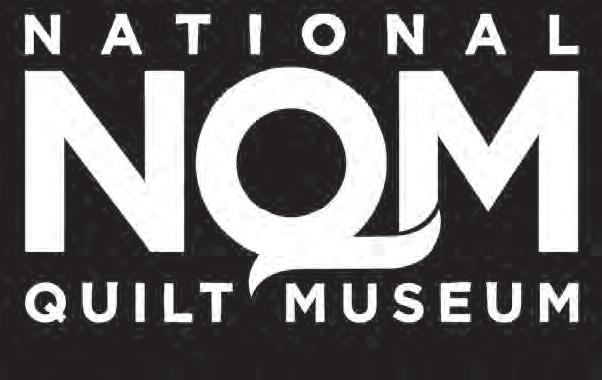
SPECIAL STAND-UP COMEDY WEEKEND STARRING LEE CRUSE
7:00 pm: Home-cooked Dinner!
8:30 pm: Live Theatre Under the Stars!

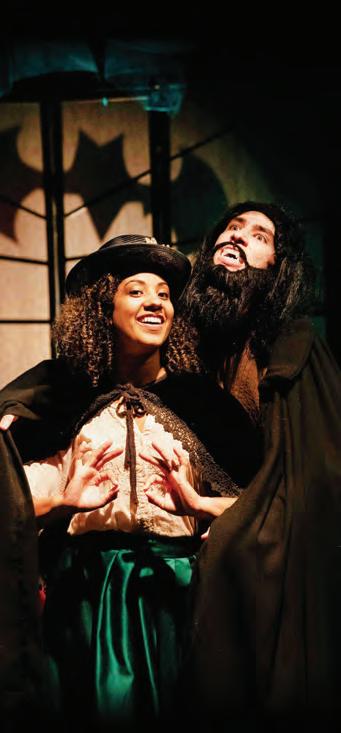
Make your reservations now! 859.236.2747
pioneerplayhouse.com

Places to stay: danvilleky.com

kentuckymonthly.com 35
THEATRE & CAMPGROUND
74
Houseboat
Heaven
BY GARY P. WEST
as an outdoor recreational site, Lake Cumberland seems to have it all. With 63,000 acres of water stretching some 100 miles, the lake provides more than 1,200 miles of mostly undeveloped shoreline. Forested foothills yield to overhanging cliffs that serve as a natural sanctuary for multiple species of birds and wild animals.
It was with Lake Cumberland in mind that Ken Vance decided in 2005 to make a career change … well, sort of. He had been in the automobile business for years, following a family tradition that began in the late 1950s with his father, Kelly Vance, in the Elizabethtown area.
“I was contacted by a friend who was one of the owners of State Dock on Lake Cumberland,” Ken said.

“Their company had decided to enter the houseboat and cruiser brokerage business.”
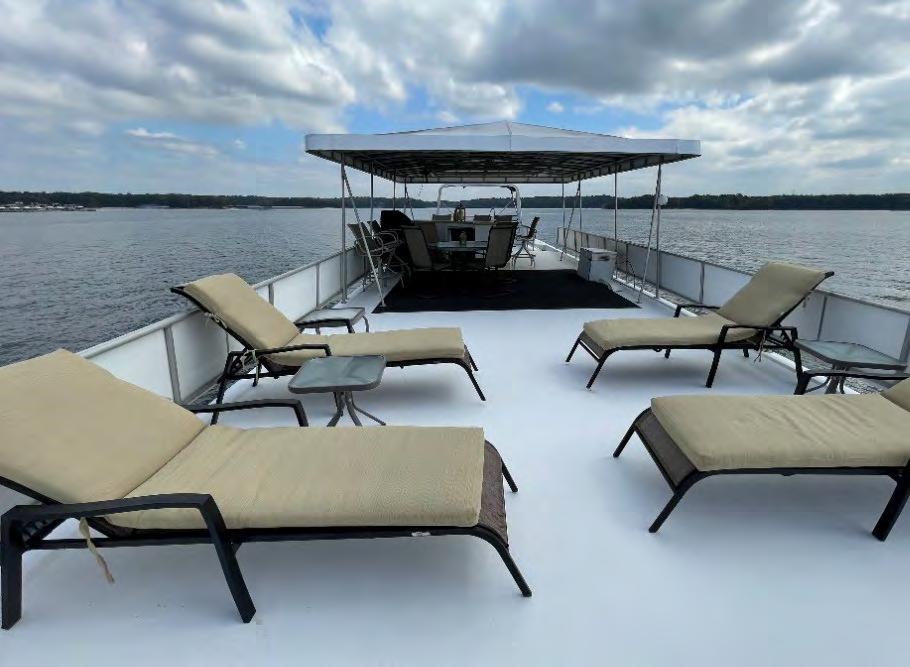

Vance made the move from selling vessels that run on asphalt to those that float on the water. Eventually, he rose to oversee Elite Boat Sales.
He had been an avid boater for more than 30 years, going from a small runabout to a 40-foot Carver Motor Yacht.
“I went from selling a car, which is a necessity, to selling a lifestyle,” Vance pointed out. “It’s similar to selling a house, except what I sell is in the water. Also, I am not required to have a real estate license.”
Lake Cumberland is known as “The Houseboat Capital of the World,” with
nine marinas spread over several counties. At one time, there were 14 houseboat manufacturers in the area. While that count is down to two, houseboats remain a primary recreational focus of the lake.
“It’s safe to say there are probably 1,800 houseboats here,” Vance said. “And on a given day, there are at least 125 for sale.”
The 70-year-old Vance has navigated regional waterways, including Lake Barkley to Wolf Creek Dam, Kentucky Lake to Knoxville, Louisville to Cincinnati, and even Kentucky Lake to Mobile, Alabama, via the Tombigbee Waterway, and then continuing to Tampa, Florida.
“I’ve been fortunate enough to sell and send boats all over the USA,” Vance said. “I’ve even sold three houseboats that went to Russia.”
36 KENTUCKY MONTHLY JUNE/JULY 2023
• • •
Ken Vance sells a lifestyle along with floating homes
Over the years, Vance received inquiries about the possibility of a reality show featuring the adventures and lifestyles of houseboating. “Most were not what I would call a good reflection on our industry,” he said.
One show caught his attention.
In August 2014, he was contacted by a production company from New York City wanting to produce a segment for HGTV titled Lakefront Bargain Hunt
“Their idea was a show featuring a prospective buyer searching for and buying a houseboat,” Vance said. “The parameter and demographics were to be a family with children looking at four different houseboats and then selecting one to buy. As luck would have it, I had sold a boat to the ideal family less than six months prior.
“A lot of viewers may not know, but these types of shows are all a reenactment of the already-completed shopping and buying process.”
Vance selected four houseboats for the HGTV show, one being the boat
the family had purchased.
“They brought in a director, producer, associate producer, two cameramen, soundman, stagers and three other assistants,” Vance said. “Two days later, a crew of three arrived to do drone shots out over the water and other locations in the area.”
Each day, the production crew filmed boats, lakeside homes, waterskiing and conversations with the “prospective buyer,” all in an effort to show viewers the quality of life a family could enjoy by owning a high-end houseboat on beautiful Lake Cumberland. After four days, HGTV had all it needed for the 30-minute show (actually 23 minutes plus seven for commercials).
Vance said the show was great exposure for State Dock at Lake Cumberland State Park and for the entire state of Kentucky. The experience left him with the untold secrets that go on behind the scenes of national cable shows such as that one.
“We had to wear the same outfits for several days to make it look like it all happened on the same day,” he
laughed. “And when our buyer looked at the houseboat he had previously bought, he remarked how much he liked the wood flooring. Truth was, he had recently installed those floors right after he purchased the boat a few months prior to filming.”



Vance found that some aspects of making TV magic were less than glamorous.
“They purchased props in the area for the show and then returned them to the stores after filming, giving the excuse they didn’t work for what they needed,” he said. “I thought that was most bizarre.”
The show initially aired on HGTV on Memorial Day 2015.
Vance noted that shows like that have a shelf life of several years. “We still get comments on it,” he said.
“It convinced me what you see as a finished product is not quite all the truth, being a reality show,” he said. “But it was a great experience that many do not ever get to be a part of.” Q
kentuckymonthly.com 37 • • •
IF YOU GO:
Weaver’s Hot Dogs
133 East Fourth Street, London 606.864.9937
facebook.com/Weavershotdogs
Open Monday-Friday, 7:30 a.m.-3 p.m. and Saturday, 9 a.m.-3 p.m.
Good Food & Good Times
A London family restaurant survived fire and COVID-19 to continue delighting local diners
BY MELISSA R. GIBSON
More than 80 years ago, Judd Weaver’s grandfather, Carl, and his wife visited family in California. There, Carl met a man in need who offered him a chili recipe. Carl tweaked the recipe, and in 1940—with a chili dog and a rented building on Main Street in London, Kentucky— Weaver’s Hot Dogs was born.
The restaurant thrived from day
one. Today, it is run by third- and fourth-generation family members Judd Weaver and his son, Judd Jr. Still, only three people know the recipe for the chili.
In the beginning, the menu included a simple breakfast (like today) and lunch hot dogs, hamburgers and RC Cola—no fries or shakes. Today, diners can choose from the famous chili dogs, hamburgers, fries, homemade chips,
soups, salads, a variety of sandwiches, and several desserts. The folks at Weaver’s are tweaking their recipe for fried apple pies.
Carl’s sons ran the restaurant for a while, and then Uncle Drew bought out his brother in 1971. Drew got rid of the pool tables and made Weaver’s into a more family-friendly place. The love for Uncle Drew shows in Judd’s face as he talks about him—his big heart, hard work
38 KENTUCKY MONTHLY JUNE/JULY 2023
ethic and short temper with kids. Judd’s dream was to get into the kitchen and make a chili dog himself, with a little onion, mustard and hot sauce, but Uncle Drew would catch him and send him out. He didn’t want anyone in his clean kitchen or messing up his routine.
As a youngster, Judd always wanted to be at Weaver’s. When he was still in diapers, he would sneak away from his babysitter and toddle a
block to the restaurant, waiting at the back door for someone to open it because he was too little to reach the handle. He remembered being lifted up to see the tops of the pool tables, with cigarette smoke swirling around. Judd ate there every day after school and couldn’t wait to work at the restaurant himself.
• • •
In 2011, Judd, a Georgetown
College graduate, and his wife, Kim, purchased Weaver’s from Uncle Drew. They had a vision of a place where people could come and be comfortable, eat good food, and have fun. They completely renovated the interior, adding space for a full bar and opening additional hours for dinner.
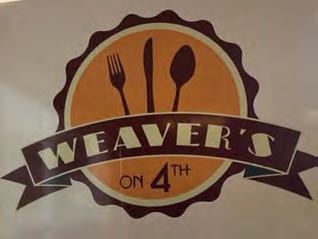
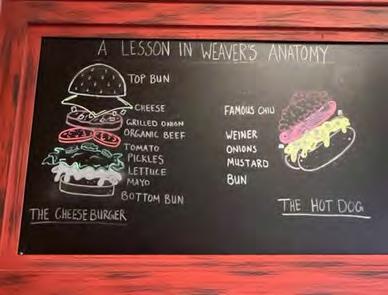

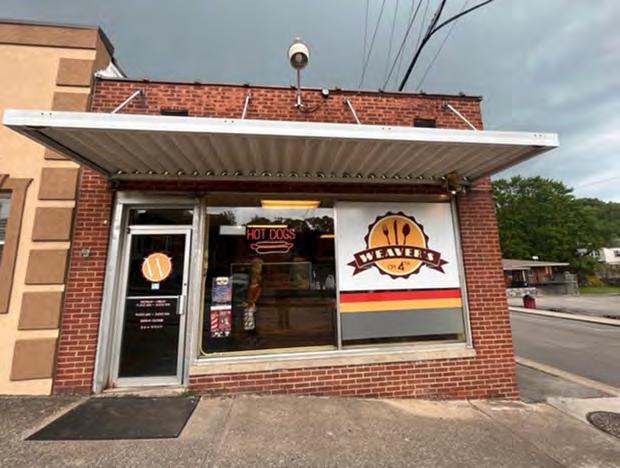
For about six months after renovation, the restaurant was doing well. During an impressionable
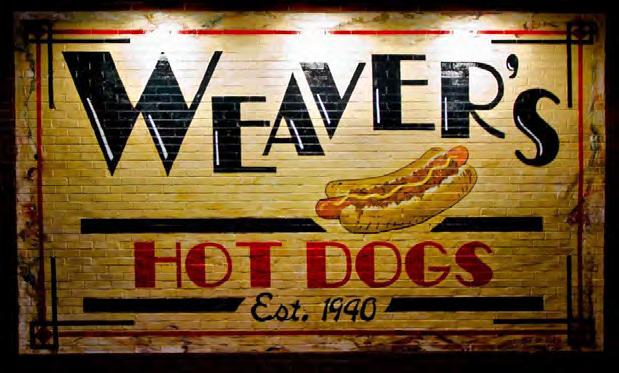
kentuckymonthly.com 39
moment, Judd and Kim were tending bar during a University of Kentucky game—the room was full, people were eating, watching the game, and having fun. Suddenly, one of UK’s players scored, and the whole place went nuts. “We looked at each other, and it was instantly—tears were running down our faces and [we were] thinking, ‘It’s here; we did it.’ Everyone having fun and getting along … That was a great memory.
“We had Exile [a popular Kentucky one-hit-wonder rock band] there, had parties, and were careful with alcohol sales. People behaved. So many good memories.”
Judd’s favorite things about his restaurant are the customers and getting up at 5 a.m. every morning to make 90 pounds of his famous chili. He doesn’t skimp on purchasing the best quality of food for his customers, buying lean, organic meat from the local C&P Meats.
When asked to share advice about running a small business in a small Kentucky town, Judd replied, “There’s nothing easy about it. You have to have the desire, a servant heart and a hard work ethic. Be well-
prepared, have a good business plan, and stick to it. But most of all, have that strong work ethic. And be careful.” Several of his employees have been with him for years.
•
•
•
The good times came to a halt when the newly renovated building burned in February 2015. The combination of an old coffee pot and a security system that didn’t work tied the Weavers up in court for four years.
The fire was devastating on more than the financial front. Many items of memorabilia were lost—photos that were more than 100 years old and vintage hats from the ’40s. A photo-lined wall held images of famed visitors to Weaver’s, including former Senator and Vice President Alben Barkley
The city’s mayor at the time, Troy Rudder, told the London TimesTribune, “The history of our city and county were on the walls of Weaver’s, from the newest birth to biggest catfish caught.”
“I’m kind of at a loss,” Sheila Wittenback, a faithful customer,
related to the Times-Tribune. “I remember when my husband and I were a young couple, [Weaver’s] had a pool hall along with the restaurant. He played pool there when he was young, and we thought in those days good girls wouldn’t go into pool halls, so we wouldn’t go in. But we could get a friend to get us hot dogs, and we ate them outside on the curb … My family’s pictures were on those walls. I for sure had pictures of several generations back on those walls. My mom’s high school trip to Mammoth Cave, my dad’s pictures from the London High basketball team in the ’50s, and pictures of my mom, myself and my daughters were on a napkin holder thanks to the previous owner, Carl David Weaver.”
The Weavers relocated and opened the new Weaver’s Hot Dogs at 133 East Fourth Street, just a few blocks from the original location, several months after the fire.

Judd said the biggest problems in today’s restaurant world are food costs, especially due to the COVID-19 pandemic, the cost of doing business in general, and finding employees, which was nearly impossible at the
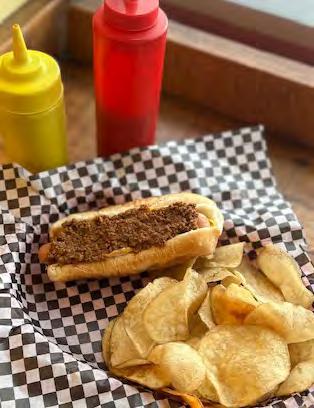
40 KENTUCKY MONTHLY JUNE/JULY 2023





kentuckymonthly.com 41 R USE PROMO CODE: DISCOUNT854 SAVE up to $31 PER TICKET Offer is online only. Valid for up to 8 discounts. No double discounts. Expires 10/29/2023. & BUY NOW SCAN HERE SAVE up to $31 PER TICKET DRONES ARE BACK! EVEN BIGGER SHOW! JUNE 17-JULY 30
height of COVID. He compares prices, shops judiciously and watches every penny.
During the worst of the pandemic, Judd had to reinvent the restaurant, going to curbside and even offering delivery. The customers and his employees were faithful and dedicated, and the restaurant survived.

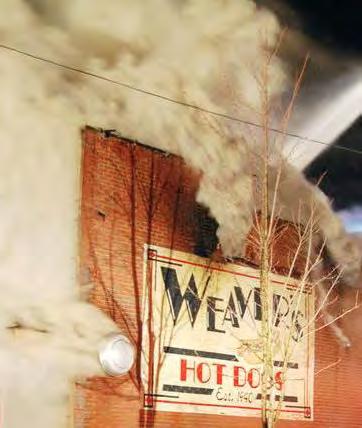
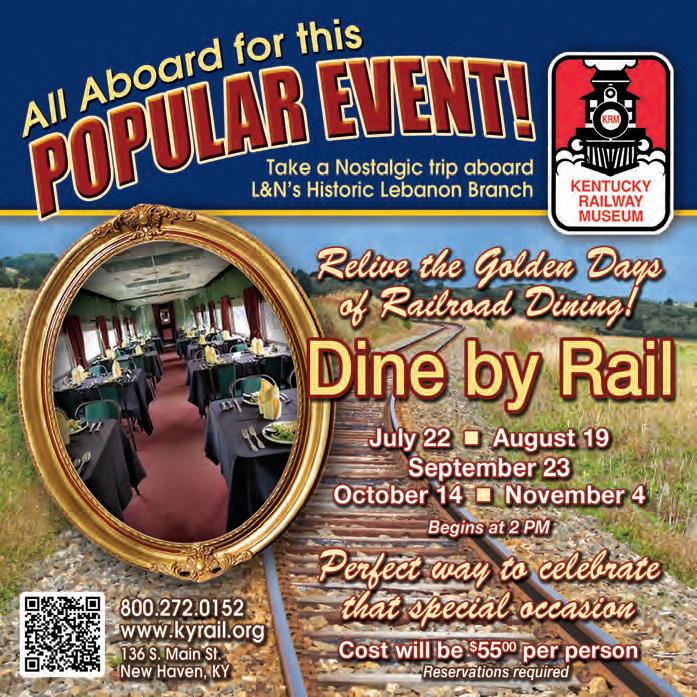
People still flock to the restaurant for hearty breakfasts and filling lunches. The beginnings of a new photo wall include a shot of Judd, his employees and former Vice President Mike Pence. Q
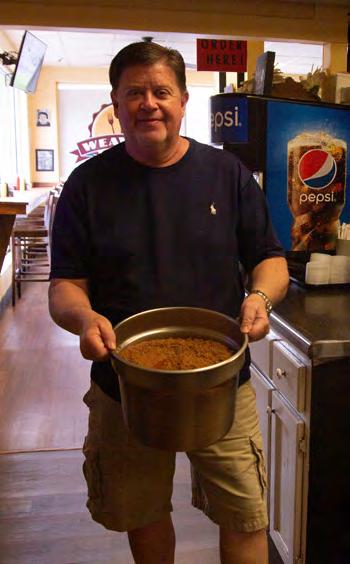
42 KENTUCKY MONTHLY JUNE/JULY 2023
Photo by Willie Sawyers of the London Sentinel-Echo.
Top, Judd Weaver with a pot of his famous chili; above, the 2015 fire that destroyed the original Weaver’s location.
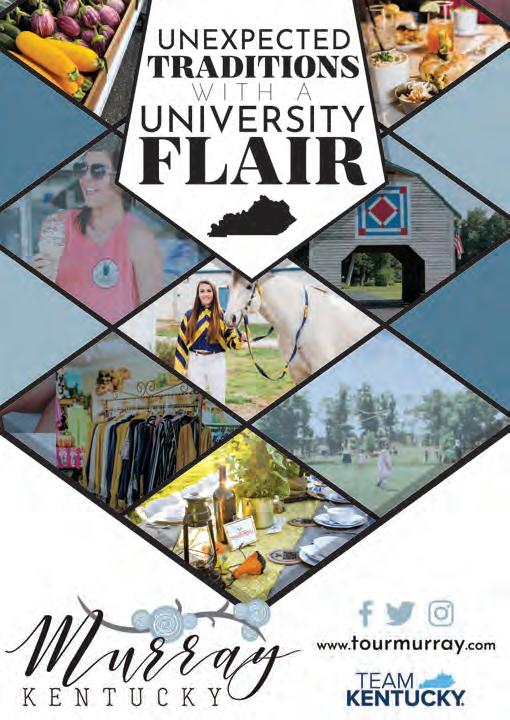










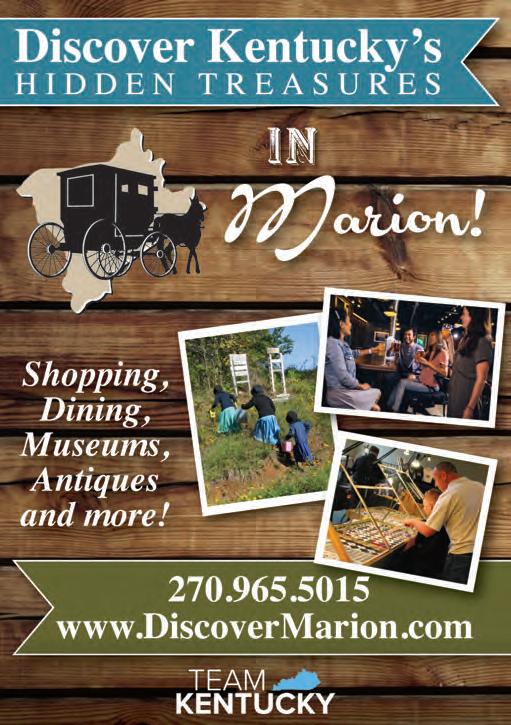
kentuckymonthly.com 43 & Crafts Folk Arts CAPITAL OF KENTUCKY Berea Experience T H E visitberea.com we know you won't leave empty handed. BEREA FESTIVALCRAFT -July 7-9 L&N DAY -June 17 C M Y CM MY CY CMY K Berea_KyMonthly_May_3.4x4.8_HR.pdf 1 5/3/23 1:32 PM General contractor specializing in new construction, home additions, home remodeling and outdoor living spaces. Remodels • Framing • Siding • Roofing • Painting Decks/Patios • Tile • Interiors • much more... SHELBYVILLE, KY • 502.437.2072 WWW.GENUINEIMPROVEMENTS.COM Claim Specialist Licensed & Insured “We are a family owned small business, but we tackle big projects!”
Maysville... Where Bourbon Began its Journey Maysville... Where Bourbon Began its Journey

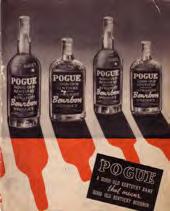
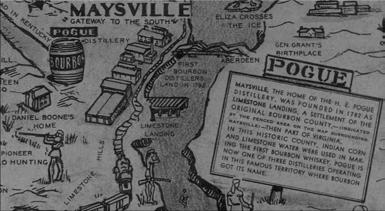


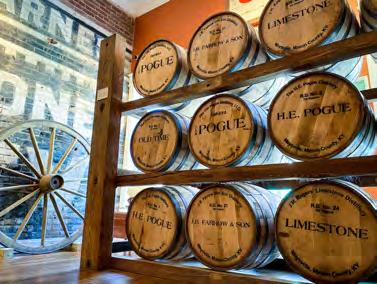
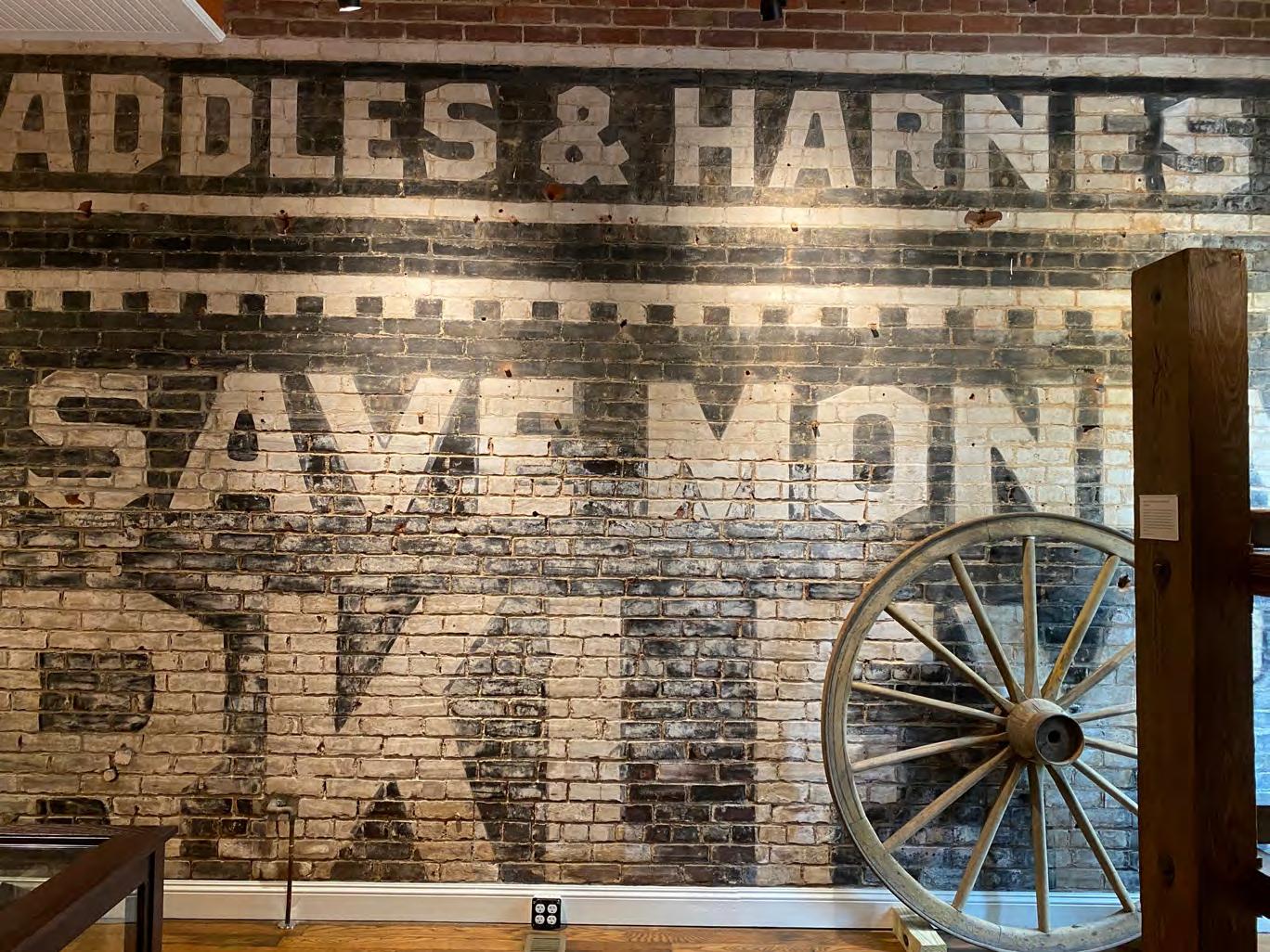
The Bourbon History Galleries at The Old Pogue Experience outlines Maysville's development of bourbon from the late 1700s to mid-1800s; the heyday of three prominent distilleries (Pogue, Limestone, Poyntz); the dark days of Prohibition; the post-prohibition era; and the renaissance of Old Pogue today.
Disclaimer: Must be 21 years of age with a valid ID to participate in bourbon tastings.
KENTUCKY GATEWAY MUSEUM CENTER 215 Sutton Street Maysville, Kentucky 41056 606-564-5865 www.kygmc.org Hours: Tuesday-Saturday 10am-4pm The Old Pogue Experience located in the limestone building on the corner of sutton & west 2nd Streets kygmc campus
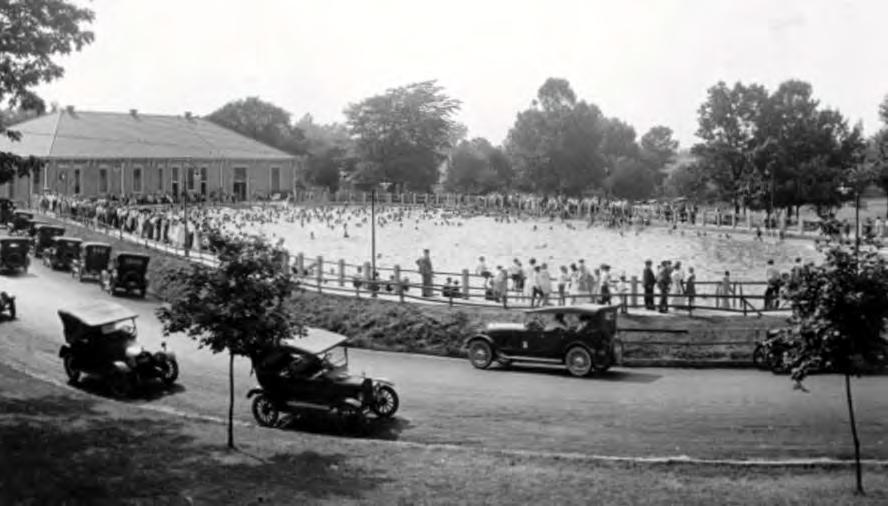
K E NTUCKY E XPLORER A section for
… inside Kentucky Monthly. Featuring Things Old & New About Kentucky Volume 38, Number 5 – June/July 2023 All About Kentucky Your Letters -- page 46 Kentucky’s Postcard Past -- page 50 James Thomas “Cotton” Noe -- page 52 “I Remember” By Our Readers and More!
The 1901 Kentucky Derby was the 27th running of the Kentucky Derby. The race took place on April 29, 1901.
Kentuckians everywhere
Crescent Hill Pool, pictured in 1921, was a popular summer attraction in Louisville. It was built by the Louisville Water Company in 1919 and was considered the largest pool in the region at the time. In the 1930s, the pool presented swimming exhibitions. One of the athletes to compete was Johnny Weissmuller, an Olympic gold medalist and swimming superstar. Weissmuller later starred in the lead role of many Tarzan movies. The pool closed in 1953.
Letters to the Kentucky Explorer
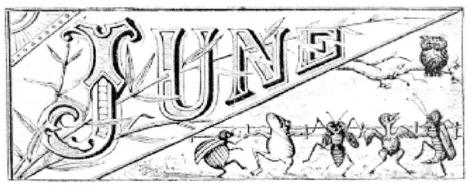
Education Is Key
I’m 85 years young and thoroughly enjoyed the article “The Gift of Literacy” by Jack Brammer (February 2023 issue, page 36). My grandparents were two of the many who took advantage of the Moonlight Schools. My grandmother, Lu Ret Tipton Finney, and her husband were taught by her sister, Minnie Tipton. Minnie attended Berea College for at least one year.
Lu Ret’s daughter, Edna Mae Finney Marcum, had six children—Roxie, Irene, Ruth, Arthur, Boyd and Virginia. Education meant a lot to Edna. She watched the older four children all graduate from college with bachelor’s degrees. Two of the children went into education and also obtained master’s degrees.

When her youngest child entered high school, Edna went back to night school, and they graduated together. Edna wanted to be able to have meaningful conversations with her children.
Education is the path out of poverty.
Ruth Marcum Sumner, Strasburg, Colorado
Memories of Jesse Stuart
In the April issue of Kentucky Monthly, Bill Ellis’ column “The Short Story” mentions Jesse Stuart, who was born and lived most of his life in W-Hollow near Greenup.
I was born and raised in Russell, the most eastern part of Greenup County. In 1955, our junior English class took a field trip to W-Hollow, and Jesse and his wife served cookies and lemonade and hosted us for several hours. He did all of his work in an authentic log cabin. It was a cozy place to write, and he was surrounded by all of his books. He and his wife lived in an old Colonial-style twostory house, about 25 yards from his cabin, which was wired for light and heat. He was about 60 at the time.
Jesse Stuart (Aug. 8, 1906Feb. 17, 1984) wrote hundreds of short stories as well as poetry and novels. He was named Kentucky’s Poet Laureate in 1954.
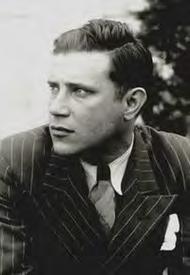
What I remember most was that he was soft spoken and gentle. On the streets of Greenup, he would speak to everybody he passed. Most of the time, he would share a story and listen to other people’s stories.
At that time, Jesse was the McKell High School principal, and my dad was a high school football referee. Jesse would meet my dad and his crew before the game each year.
Jesse remembered names by remembering something about the person. For example, on our field trip, I mentioned my dad to him, and Jesse said, “Oh yes, Gene Harris, Football Legs.” Dad only talked to him once a year.
My senior class sent out letters asking for donations of items to sell to support our class trip to New York City. Stuart sent us cash and several books. Things were cheaper in 1955.
I read many of Stuart’s books and could visualize everything he wrote about. I fished and hunted around the W-Hollow area.
J.R. Harris, Louisville
46 THE KENTUCKY EXPLORER Kentucky’s only physician-governor,
was born June 16, 1816, in Woodford County. FOUNDED 1986, VOLUME 38, NO. 5 a magazine published for Kentuckians everywhere Charles Hayes Jr. • Founder Stephen M. Vest • Publisher Deborah Kohl Kremer • Editor Rebecca Redding • Typographist
Explorer One-Year Subscription to Kentucky Monthly: $25 Kentucky Explorer appears inside each issue of Kentucky Monthly magazine. Subscriptions can be purchased online at shopkentuckymonthly.com or by calling 1.888.329.0053. Please send letters to Editor Deborah Kohl Kremer at deb@kentuckymonthly.com or mail to Deb Kremer, Kentucky Monthly, PO Box 559, Frankfort, KY 40602.
Luke Pryor Blackburn,
Kentucky
Letters may be edited for clarification and brevity.
In memory of Donna Jean Hayes, 1948-2019
A new feature for Kentucky Explorer readers: Louisville Courier-Journal Culinary Archive
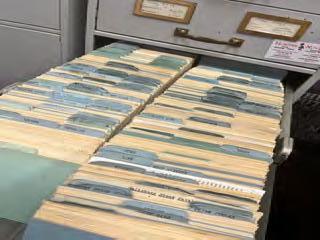

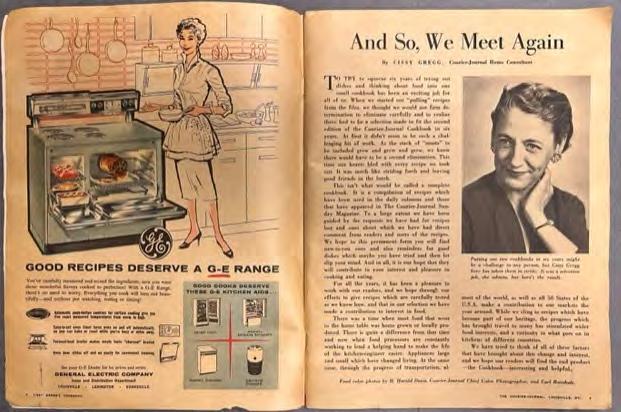 By Jackie Young, MLS, Ed.D. Library Director, Sullivan University
By Jackie Young, MLS, Ed.D. Library Director, Sullivan University
Before the Food Network or Instagram, there were newspaper food sections, and they were wildly popular. Often the most-read section of the paper, the food section (sometimes called the Women’s Page) in large papers such as the Louisville Courier-Journal employed college-educated home economists, dietitians, cooks, critics and photographers to bring readers a daily diet of recipes, household tips and trends. Some were so popular that they branched out to other media outlets. Cissy Gregg, food editor at the CourierJournal (c. 1943-1963), started a call-in radio show on WHAS in 1953 and was a popular lecturer throughout Kentucky.
The food department was a busy place. With producing daily columns as well as enlarged Sunday sections, the staff was responsible for researching food history and trends, explaining current cooking methods, introducing the latest kitchen equipment, testing each recipe, writing engaging copy, designing sets and photographing all of it. Food editors and writers often became beloved personalities in their communities and had wide name recognition. Today, people still remember and speak fondly of Cissy Gregg and make her recipes as well. Cissy was Louisville’s Julia Child, Martha Stewart and Rachael Ray all rolled into one.
In the summer of 2021, the Courier-Journal senior photographer Pat McDonogh approached Sullivan University with an offer. The Gannett Corporation, the Courier-Journal’s parent, was selling the iconic Louisville building on Broadway and asked if the university would be interested in taking its culinary archives. Everything needed to go, including a large collection of books, recipe cards, research files, volumes of clippings, kitchen utensils, set props and even the literal kitchen sink. Otherwise, it was going to be demolished. While Sullivan did not take
the actual sink, appliances and cabinetry, we did accept the recipes, books, research files and a selection of utensils and props from the 1930s through the 2000s. And what a collection it turned out to be! There are more than 30,000 recipe cards, 1,500 cookbooks, years worth of newspaper clippings, and boxes of kitchen paraphernalia. Within all this is a rich history of Louisville and Kentucky—and not just culinary history. Hopefully, this column will rekindle some memories, explore long-forgotten recipes, and be a fun look back at how Kentucky cooked. We will feature a historic recipe from the collection in this column each issue. This month, to kick off this partnership, the Kentucky Monthly Cooking column (beginning on page 12) presents five dishes that we recreated with the help of Chef Ann Currie
We don’t mean to string you along but you might be nearly ready to can green beans yourself. Here is some advice from 81 years ago.
If you would like more information about Sullivan University, please visit Sullivan.edu or call 1.800.844.1354.

June/July 2023 47
The Lexington Opera House officially opened on July 19, 1887.
“I Remember” By Our Readers
What Came Down the Pike
Lest We Forget is a book written in 1974 by Lynnie Davis White of Steubenville in Wayne County. She assembled memories and typed (or had them typed) and copied them to create a 70-page book that she dedicated to her grandchildren. It does not give the year of her birth, but it appears she was born around the turn of the century. The youngest of 13 children, she wanted to share with her family what it was like growing up without electricity, running water, a telephone or central heating. Here is an excerpt from her collection.
Editor’s Note: The Pike the writer refers to is Burnside Pike, also known as Ky. 90
The road or pike ran through the center of our community. I suppose there had always been a road there. I remember my aunts telling me about standing under a tree about one-half mile from the road watching the Southern soldiers retreat down the road toward Monticello during the Battle of Mill Springs in the War Between the States. I suppose the pike followed about the same route that the old road did. The pike was there when I can first remember. It was built by a company of men from Pulaski and Wayne counties. I believe the company was local men, no outsiders. It came from Burnside to Monticello, and it must have meant much to the people of Wayne County. I have heard old people talk about when they were building the pike. My mother talked about going to the commissary, where you could buy groceries and other necessities. It was run by the company and was over at the old Anderson home. I supposed this was the first store for miles.
I guess the pike was built entirely by hand except for teams to move the rock. Sledgehammers and napping hammers were the only tools; they did not have machinery. It must have been quite a job and must have
taken a long time. When it was finished, it had five toll gates from Monticello to Burnside. I believe that it cost 25 cents for a wagon and buggy at each toll gate. Most of the keepers put the pole down at nine o’clock at night, and if you wanted to get through after that time, you had to wake them. If you were riding horseback, you could just ride around the pole. Not many people were traveling later than nine o’clock in those days.
Sometime during the 1920s, with much rejoicing, the toll gates came down. The young people of Monticello dragged the one at upper Monticello through the town.
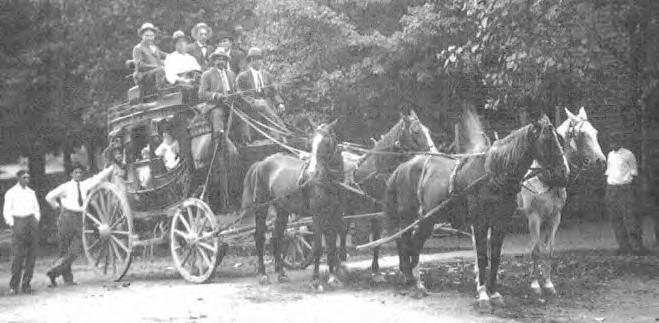
Going up and down the pike, I saw things that we will never see again. I have seen wagons, buggies, horseback riders and walkers but also the old stagecoach. Back then, it was a fine-looking vehicle that always had four highstepping horses and people sitting on the top of the stage looked like people from another world. There were also covered wagons. They would be five or six in a row bringing freight into Wayne County. All the stagecoach drivers and covered wagon drivers did their part in making our county what it is.
Another common sight was the droves of cattle, hogs, sheep, horses and even turkeys that would be driven to Burnside by foot to the railroad. It was mostly cows, but it would have two or three hundred in a drove. The drovers would always stop at the school and get some of the bigger boys to help drive them through the gap of the ridge as there were no fences in the gap then, and they needed help to keep their animals from scattering in the woods. The boys always wanted to go. It meant getting out of school for a little while and getting a dime for helping. The teachers always let them go.
I have seen circuses come down that pike. This was the greatest thing of all, to see lions and tigers in their cages and elephants and camels walking down the pike. It made all of us want to go to the circus. Can you imagine elephants and camels walking down our highway now?
4 THE KENTUCKY EXPLORER 48 THE KENTUCKY EXPLORER
Send your memory in today! Henry
on June 29, 1852. He was the first person to lie in state in the United States Capitol
Send memories to Deborah Kohl Kremer at deb@kentuckymonthly.com or mail to Kentucky Monthly, Attn: Deb Kremer, P.O. Box 559, Frankfort, KY 40602.
Clay died
rotunda.
The Monticello-Burnside Stagecoach, circa 1915. Photo from Elmer L. Foote Lantern Slide Collection at the Lexington Public Library. Courtesy of Wayne County Historical Society.
Bible School Crafts
By Roger L. Guffey, Lexington
Nearly all churches in my hometown of Monticello offered Vacation Bible School to provide social opportunities for children from preschool to high school years. Typically, these classes were held in the afternoon when it was too hot to work outside.
Adult volunteers taught lessons on well-known Bible stories. Church ladies baked hundreds of cookies and made gallons of lemonade for refreshments. And the children played red rover, hide and seek, run sheep run, and tag for recreation.
The centerpieces of Bible School were the arts and crafts that students completed during the weeklong sessions. The church men supervised boys and used power tools as they built birdhouses or other simple wooden projects. Small children used scraps of cloth to transform old-fashioned clothespins into people and angels from their favorite Bible stories. Older girls created jewelry boxes from cigar boxes and dried pasta.
Shank’s Mare
By David R. Caudill, Daytona Beach, Florida
Shank’s mare, also known as shank’s pony or shank’s nag (Scottish spelling is naig), means to go on foot or walk. As many of you know, a shank is the shinbone of an animal.
My family moved to Kentucky in 1953 to the homeplace at the head of Rockhouse Fork of Big Willard Creek in Perry County. I quickly noticed the lack of amenities there—most notably the lack of telephones and public transportation. The closest telephone was 5 miles away. This left us isolated. Even if there were telephone lines up in the hollows, few could have afforded phone service.
To compound the problem was the lack of cars. Unlike today, where most families have at least two cars in the garage, many families had none. In the 1950s, if a family had a car, it was used to get to work.
If a teenager wanted to talk to a friend, it was shank’s mare. If you wanted to see a girl, you either made that date
Rural Western Kentucky Farm Life
By Betty Osbron, Murray
I grew up on a farm in western Kentucky. Daddy and Mother cultivated dark-fired tobacco, corn and wheat. Our family raised cows, pigs and chickens. We had an old mule named Kate. Daddy let me work tobacco with him, and I was allowed to mow with the tractor.
I had an older sister, Carolyn, who also worked in the fields. We had a garden and what was called a truck patch. The truck patch was planted later in the summer so that we could have vegetables until fall. There was a strawberry patch and apple, peach and pear trees.
Mother canned green beans, corn, sauerkraut, beets, dill pickles, 14-day pickles and pickled peaches. She canned meats because we didn’t have a freezer. There were jams and jellies from the fruit we harvested.
The churches coordinated the Bible Schools, so that children could attend several different of them throughout the summer. Denominational labels were replaced by opportunities to make new friends, practice reading skills, and produce works of art made by their own hands.
One summer, I attended Bible School at Bethesda Methodist Church, where I made a jewelry box for my mother, even though she never wore jewelry other than a simple brooch. My oldest brother gave me a Swisher Sweets box for the project. Small elbow macaroni glued onto the box and two coats of metallic gold paint later, and I had a nice gift for my mother to set on her dresser. The box was lost long ago, but the fond memories remain.
Today pasta comes in several different shapes and the little wagon wheels of rotelli pasta are perfect for these boxes. I made this one using rotelli pasta, a hot glue gun, and fake gemstones as an homage to my mother and those simpler times.

at school or—you guessed it—shank’s mare. To get the mail, you used shank’s mare to go to the general store where the mailman left everybody’s mail. The school bus came within only 1 ½ miles of my house. All my friends and I came out of the hollows to catch it. If you wanted to go to church, it was shank’s mare. My future wife’s church was in Yerkees, more than 6 miles away. Again, I employed the old mare there and back. We walked everywhere! When our school bus broke down, we walked home.
One result of the walking was healthy bodies. Today, many go to a fitness center to do just what we did in the ’50s. Little were we aware at the time that we were strengthening our hearts, lungs, and muscles. We also gave no thought that by walking, we had the opportunity to get to know the families up and down the creek.
Decades have passed since those days, but I can still remember most of the faces of the families along the creek, and I am still sound in body and mind at 84. I attribute much of that to shank’s mare.
In the fall, we had a hog killing. When the days started to get cooler, all of the neighbors got together to slaughter and process pigs for the months ahead. The women ground sausage, and the men rendered the lard from the fat until it was a beautiful snow white. We used it to season vegetables and in frying meat. Cracklins were left over from processing the lard and were used to make cracklins cornbread.
Daddy smoked the hams, shoulders, bacon and jowls in our tobacco barn after he had salted them. We ate most of this meat, but Daddy sold a few hams and shoulders, as they brought in a lot of money. For breakfast, we had the blessing of eating ham, sausage, bacon, eggs, homemade butter, jams and jellies.
I wouldn’t trade the sweet memories of my young life on my parents’ farm for anything. We worked hard and loved harder.
Country musician Ricky Skaggs was born on July 18, 1954, in Cordell.
June/July 2023 49
A jewelry box made with wagonwheel pasta.
Kentucky’s Postcard Past
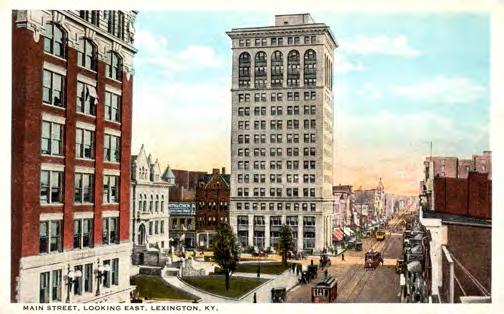 By Terry L. Baldridge, Argillite
By Terry L. Baldridge, Argillite
Today, many people use social networks and texts to share photos and messages. No matter the distance between sender and recipient, the time it takes for these messages and photos to be viewed is almost instantaneous. A century ago, the postcard was the text or post of the day, and many postcards had photographs on the front. The sender would convey a message on the back or side and include an image of their whereabouts or places visited.
Postcards were a way for businesses, churches, cities, clubs, schools and others to advertise everyday scenes of the time. Often, art or photographs were hand colored and provided an “in-the-flesh view” of the surrounding areas. Many of these scenes or structures have long ago faded into the past, and it is through viewing an old postcard that we can see them in their heyday.
Postcard historians generally have divided postcards into eight historical phases: the Pre-Postcard Period, 18481870; Pioneer Period, 1870-1898; Private Mailing Card Period, 1898-1901; Post Card Period, 1901-1907; Divided Back Period, 1907-1915; White Border Period, 1915-1930; Linen Period, 1930-1945; and Photochrom Period, 1945-present.
Many postcards depicting scenes across Kentucky were produced throughout the eight historical phases. Why not make it a goal to explore these long-lost images of your section of our beautiful Commonwealth? It was a time when people from Kentucky took pride in the varied facets of their lives and wanted to share that pride in the form of images via a postcard, a message and a 1-cent stamp.
For more infomation, check out one of the author’s books on Kentucky postcards, www.terbald.com

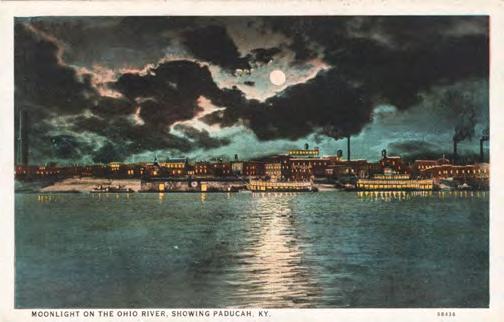
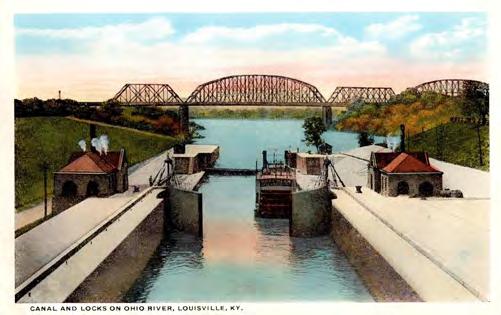
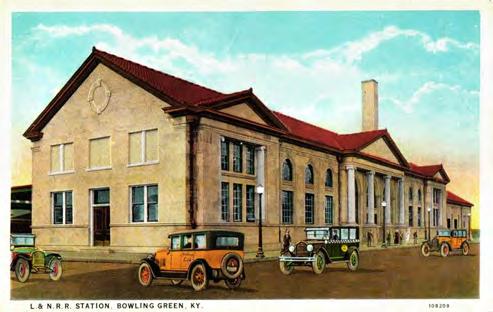
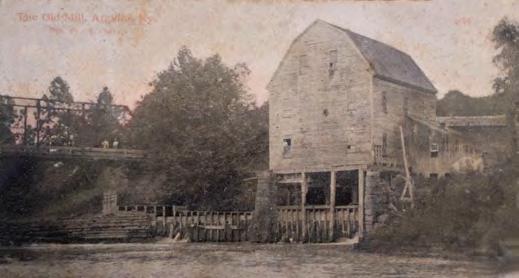
6 THE KENTUCKY EXPLORER 50 THE KENTUCKY EXPLORER
The first recorded celebration of Independence Day in Kentucky was held in Jessamine County on July 4, 1794.
Clockwise from top left: The old canal and locks in Louisville are the subject of this 1910 color postcard; this postcard shows Lexington’s everyday life on Main Street, complete with streetcars, from around 1915; when it opened in 1867, the Roebling Suspension Bridge crossed the Ohio River between Covington and Cincinnati and was at that time the longest bridge in the world. This postcard shows the entrance to the bridge from the Covington side; a postcard view of the Old Mill that sat on the western bank of the Little Sandy River at Argillite. The foundation of the mill was made from stones from the old Argillite Iron Furnace. This postcard photograph is from around 1899; many Kentucky towns had railroads that have long since disappeared. Most town depots produced postcards to promote their rail service. This postcard, from the 1920s, is of the L&N Railroad Station in Bowling Green.
A rare night postcard view of Paducah. The photo for this postcard most likely was taken during the day, and an artist painted in the night elements.
Milk Sickness in the Early 1800s
By Roger Keith, Clearwater, Florida
Life was difficult in the early Kentucky settlements. Each passing year, there seemed to be some new illness or disease brought by the thousands of settlers crossing through the Cumberland Gap or floating down the Ohio River into Kentucky.
In the early 1800s, a deadly new illness arrived on the Kentucky frontier. It was so powerful that, in some instances, it wiped out entire families and devastated rural farming communities. This illness, known today as milk sickness, was then called “the trembles” or “the slows” in farm animals such as the cattle, horses and sheep that also caught the disease. In humans, it was characterized by loss of appetite, vomiting, severe intestinal discomfort, muscle stiffness and eventually coma. Recovery was often slow, if at all. Most often, the illness resulted in a painful death.

This deadly sickness was not isolated to Kentucky. It was found in Ohio, Illinois, Indiana and Tennessee. In 1818, it took the life of Abraham Lincoln’s mother, Nancy Hanks Lincoln, when an outbreak of milk sickness struck her home at the Pigeon Creek settlement in Indiana.
It wasn’t until 1809 that a Bourbon County physician, Dr. Thomas Barbee, made the first diagnosis. He called it milk sickness. The most popular cure of that day was bloodletting. Unfortunately, this procedure did nothing for those who became afflicted with milk sickness.
By 1830, the illness was so prevalent in Kentucky that the state General Assembly offered a $600 reward to anyone who could discover its cause. Although many physicians and scientists took up the challenge, the discovery would not come easily. When it was discovered, it came at the hands of a female physician, Dr. Anna Pierce Hobs Bixby of Illinois.
When Anna was 16, her parents crossed over the mountains into Kentucky from Philadelphia. From there, they continued on to southeastern Illinois, where they settled. Eventually, Anna returned to Philadelphia and studied to become a physician. Always concerned about the health of her family and community, she returned to southeastern Illinois, where she was the only physician.
After losing her mother and sister-in-law to the dreaded milk sickness, Anna was determined to find the cause. Research led her to discover that the illness seemed to be caused by drinking milk or eating butter. She also discovered that the illness appeared to be seasonal, at its worst during the growing season and falling off dramatically after the first frost.
With those clues, she began a study of farm animals
and discovered that, while horses and sheep became infected, cattle seemed most likely to be the carrier. An interesting detail concerning the cattle was that the adult cows did not die of the disease, but their calves did. Anna reasoned that the illness came from a plant or an herb that cows ate but other farm animals didn’t typically consume. Still, she had no idea what that herb was.
As can be the case with great discoveries, an outside individual unexpectedly gave a bit of information that solved the puzzle. In this case, it came from an odd but fortuitous encounter with an unlikely person.
One day, Anna followed a small herd of cattle as they grazed in the woods. She was interested to see for herself what the cattle were feeding upon. During this foray, she happened upon an old Shawnee medicine woman who had been left behind by her tribe when they relocated west of the Mississippi. Anna, feeling sorry for the woman, took her back to her home to care for her. After learning that Anna was trying to find out what caused the milk sickness, the old woman took her back to the forest and showed her a plant called white snakeroot. She said that the herb was the cause of the illness.
Anna conducted several tests and found that the rather common flowering plant growing in the shade of the boundary line between pasture and forest was indeed the cause of the deadly illness that had killed so many.
The solution was to simply destroy the plants and manage the cattle better in their pasture. The deadly milk sickness began to wane once its source was known. It wasn’t until 1928 that the American Medical Association formally recognized the cause of milk sickness to be the white snakeroot plant. Anna died of a heart attack in 1869 at age 61, never having received recognition for her contribution to medical science and the prevention of milk sickness.
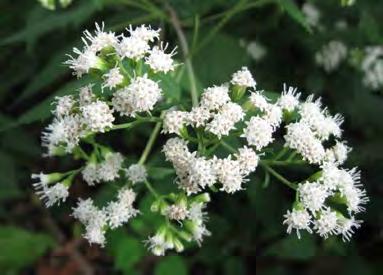
June/July 2023 51
The Wayne County seat, Monticello, was named for the home of Thomas Jefferson.
Left, the culprit: white snakeroot.
Dr. Anna Pierce Hobs Bixby solved the mystery of
Kentucky’s First Poet Laureate: James Thomas ‘Cotton’ Noe
By John W. McCauley, Lexington
In 1926, the Kentucky General Assembly selected James Thomas “Cotton” Noe as the state’s first poet laureate. Noe felt there were better choices and that the legislature had acted in malice aforethought. Noe would quickly tell you that he was a teacher and not a professional poet. Writing poetry was a passion and diversion, and he prided himself in the philosophy of the simpler verse.
Noe was born to John Washington Noe and Margaret Ann Trowbridge on May 2, 1864, near Springfield in Washington County. He was the oldest of four siblings and had one brother and two sisters. He received a formal primary and secondary education before attending Franklin College, a private liberal arts institution in Franklin, Indiana. While at Franklin, Noe won numerous awards and graduated with an A.B. degree.
He taught high school for a couple of years before attending Cornell University to study English literature with a focus on Shakespeare. In 1890, Noe earned his master’s degree and returned to Kentucky to teach. Following a stint in Marion County, Noe was hired by the Williamsburg Institute, now the University of the Cumberlands, a Baptist-affiliated college in Williamsburg. It was during Noe’s short tenure in Williamsburg that he met Sidney Stanfill, his wife-to-be. The couple married on May 2, 1894.
The Noes left the southeastern Kentucky mountains and relocated to his hometown of Springfield, where he practiced law and served as a police judge. However, by 1898, this talented educator had returned to the classroom. Noe taught at several high schools and institutions of higher learning, including Lincoln Memorial University in Harrogate, Tennessee. In the ensuing years, Lincoln Memorial University also would claim Kentucky author and poet laurate Jesse Stuart, who was a student, and William H. Townsend, Kentucky author and an Abraham Lincoln authority and collector, who served on the board of trustees. The three Kentucky authors became close friends.
In 1906, Noe made his way to Lexington, where he became a professor of English at the Agricultural and Mechanical College of Kentucky, now the University of Kentucky. By 1912, Noe had become the head of the university’s Department of Education and remained in that
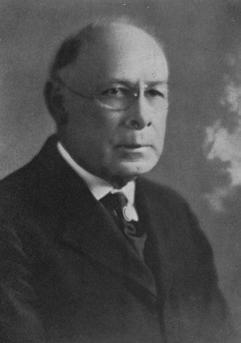
post for 11 years. After stepping down in 1923 as department head, he continued on the faculty until 1934. He then retired from full-time teaching and moved to Beverly Hills, California.
Noe was one of the great writers of his day and was a fine choice by the Kentucky General Assembly for our Commonwealth’s first poet laurate. His works included The Loom of Life (1912), The Blood of Rachel (1916), Lincoln and Twenty Other Poems (1922), Tip Sams of Kentucky (1926), The Legend of the Silver Band (1932), The Valleys of Parnassus (1935), A Brief Anthology of Kentucky Poetry (1936) and In Kentucky (1940).
In this author’s William H. Townsend Library, I have copies of The Blood of Rachel and The Legend of the Silver Band, both inscribed by Cotton Noe to his good friend Townsend. For a literary collector and enthusiast, these books are a real treasure.
Following is a sample of how Cotton Noe was an artist of the simpler verse.
In the Mountains
I met a little mountain boy As I rode through the vale; His tiny sister trailed behind, With pawpaws in a pail.
I greeted him: “How are you?” He tipped his cap, “I’m six.” “Where do you live?” He smiled and said, “Oh, back there in the sticks.”
Then, “Won’t you have a pawpaw, Sir? We gathered them to-day.” I did not like the fruit, but said, “Why thank you, if I may.”
He held the pail of pawpaws up, “My sister here is four; Her birthday was last week,” he said, “Sir, won’t you have some more?”
A jaybird blew his clarinet, A brown thrush tried to trill; The boy went whistling down the path, As I rode up the hill.
Cotton Noe Tip Sams Of Kentucky (1926)
Noe held the title of Kentucky poet laureate from 1926 until his death on Nov. 9, 1953, in Beverly Hills. He is buried in the Lexington Cemetery just a short walk from his old friend, Townsend. Noe was the state’s longestserving poet laureate.
52 KENTUCKY MONTHLY NOVEMBER 2020
52 THE KENTUCKY EXPLORER
Paducah served as a massive supply depot for the Union Army along the Ohio, Mississippi and Tennessee rivers.
Kentuckian Grandpa Jones
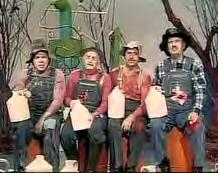
Louis Marshall Jones was an American country music singer and songwriter who was better known by his stage name, Grandpa Jones. He was born on Oct. 20, 1913, in Niagara in Henderson County and began his career as a musician in the 1930s, when he joined the Pine Ridge String Band.
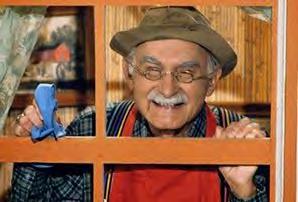
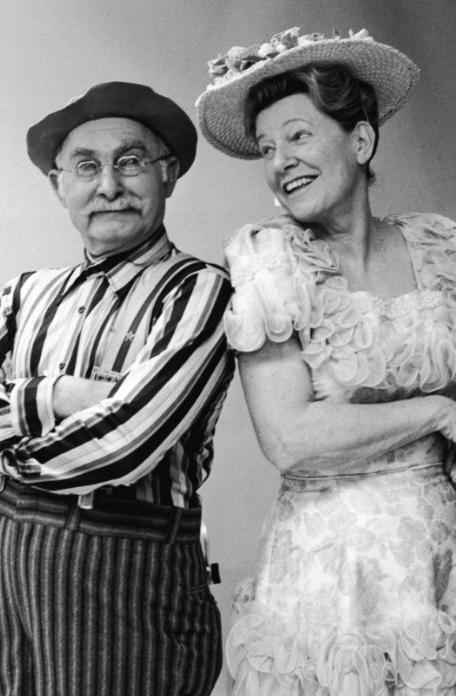
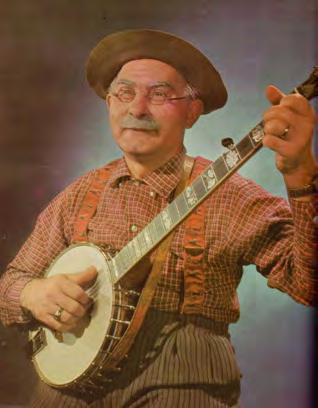
When he was 22, Jones began working with WBZ radio in Boston. He was not a fan of early mornings, and offstage, he had a grumpy disposition, which caused a fellow musician to nickname him Grandpa Jones. He embraced the moniker, and it stuck.
Jones was known for his distinctive style of banjo playing and his humorous songs and stories. He became a regular performer on the Grand Ole Opry radio show in the 1940s and was on the show for many years. He also appeared in several movies and television shows.
He is best known as one of the original cast members of the popular TV show Hee Haw, which debuted in 1969. Jones had recurring music and comedy roles. One segment included the audience asking, “Hey, Grandpa, what’s for supper?” He also appeared frequently in skits with Minnie Pearl and with the Hee Haw Gospel Quartet, which recorded six albums.
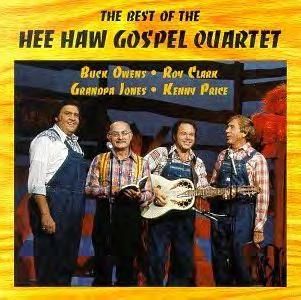
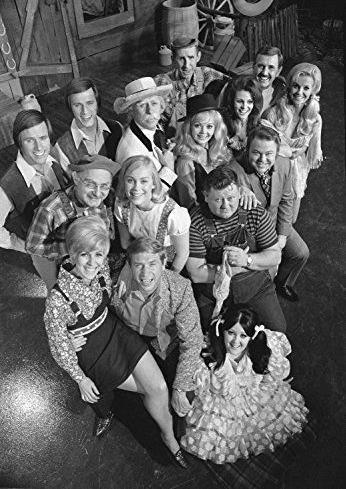
Jones was inducted into the Country Music Hall of Fame in 1978. He died on Feb. 19, 1998, at age 84.
Cruising on the Cumberland in the Late 1800s
The first wedding recorded in Gallatin County was that of Nicholas Lantz and Mary Pickett on July 18, 1799.
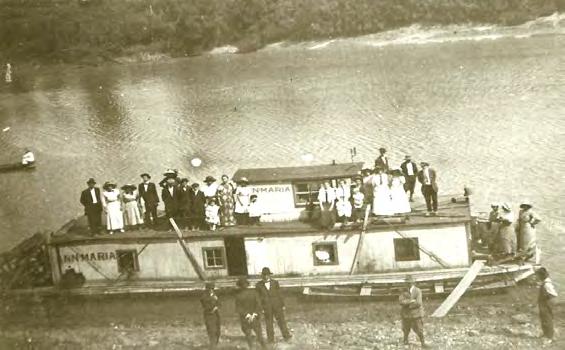
June/July 2023 53
Grandpa Jones with his trusty banjo and, below, in his memorable Hee Haw roles.
This boat was owned and operated by Percy White (1869-1957), owner of the Cadiz Milling Co. White used it to sell flour, meal and other milling products up and down the Cumberland River, which is now Lake Barkley.
Photo courtesy of the Trigg County Historical & Preservation Society, Inc., donated by Stan White, the grand-nephew of Percy.
Follow the Trigg County Historical & Preservation Society on Facebook.
1916:
Chicago
Bourbon Men Visit Kentucky
Trip included Mammoth Cave, Churchill Downs and Old Charter Distillery
By Bob Thompson, Mason Ohio
Kentucky and Kentuckians have long been noted for their hospitality, distilleries and famous attractions. It was no different in May 1916, when a party of 100 liquor dealers from Chicago made the trip by train to the state as guests of Wright and Taylor, a Louisville distillery wholesale house. John J. Wright and Marion E. Taylor were well-known successful whiskey men with wellestablished brands that included Pride of Louisville, Cane Spring, Kentucky Taylor and “Old Logan.”
Wright and Taylor also owned Old Charter, a popular brand of Kentucky bourbon that was introduced in 1874 by Adam and Benjamin Chapeze. The Chapeze brothers built the Chapeze Distillery at Chapeze Station (later called Limestone Springs) on the Bardstown-Springfield branch of the L&N Railroad in 1867. Although whiskey labels from Old Charter mention the Chapeze Distillery location as Nelson County, from examining old maps, it was discovered to be located in Bullitt County near Clermont.
In 1890, the Chapeze Brothers sold their label and existing stock to Leman and More, who in turn sold it to Wright and Taylor, who purchased the Old Charter Distillery and brand on July 28, 1896. Under their ownership, the name of the distillery was changed from Chapeze to Old Charter. The Old Charter brand was trademarked by Wright and Taylor in 1907.

An article from The Wine and Spirit Bulletin, June 1, 1916, mentions the Chicago men’s trip to Kentucky, “There were two distinctive features of the entertainment of this party of liquor men by the distillers of ‘Old Charter’ whiskey, one being the trip to inspection through the ‘Old Charter’ Distillery, where every process of the manufacture, maturing and handling of this fine whiskey was explained and demonstrated, and of all which proved to be not only interesting but instructive to the men whose business it is to serve beverages, and who thereby learned what makes a fine beverage whiskey and came away assured that ‘Old Charter’ is well placed in this category. The other feature especially to be mentioned is the trip to Mammoth Cave, which has a world-wide reputation, and which all visitors
to Kentucky are anxious to see.”
After a morning visit to the Old Charter Distillery on May 22, the Chicago group arrived at Mammoth Cave by train that afternoon. After a 6:05 p.m. arrival, dinner was served at the old Mammoth Cave Hotel. At 7 p.m., the group made a four-hour trip into the cave. Following an overnight stay at the hotel, the men had breakfast before returning by train to Louisville for a visit to Churchill Downs and a special evening banquet provided by the guest host, Wright and Taylor, before returning by train to Chicago.
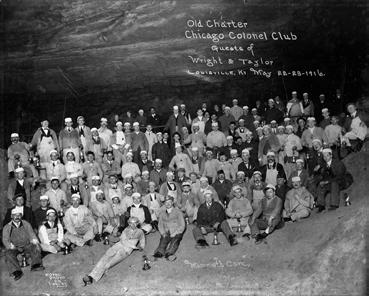
As a special memento of their Kentucky trip, a photographer from the Royal Photo Company of Louisville accompanied the group and took photos at the distillery and inside Mammoth Cave.
In 1933, the Old Charter Distillery closed, and Bernheim Distillery acquired the Old Charter Brand from Wright and Taylor. Bernheim sold out to Schenley Distilleries in 1937. The Old Charter brand was purchased by the Sazerac Company in 1999. Old Charter whiskey is still produced today and distilled in Frankfort by Buffalo Trace Distillery.
The old Chapeze/Old Charter Distillery tract is now owned by Jim Beam Brands and is adjacent to its distilling operation in Clermont. Old Charter, distilled for more than seven generations, remains a prominent Kentucky bourbon brand and is one of the oldest continuously marketed bourbons in America.
On a side note, the Czechoslovakia scenes in the 1981 movie Stripes, starring Bill Murray and Harold Ramis, were filmed at the site of the Chapeze/Old Charter Distillery. Who knew that a Kentucky bourbon distillery could be a stand-in for Czechoslovakia?
54 THE KENTUCKY EXPLORER
Lexington was named in June 1775, in what was then Fincastle County, Virginia.
Above left: The group of visiting Chicago whiskey men pose in front of the business office of the Chapeze/Old Charter Distillery, May 22, 1916. This building remains standing today and is owned by Jim Beam Brands; right: the Old Chicago Colonel Club, guests of Wright and Taylor, in the interior of Mammoth Cave, May 22, 1916.
In Memory of the 2022 Eastern Kentucky Floods


Record-setting rainfall impacted 13 counties across the eastern portion of Kentucky in July 2022.
According to the National Weather Service, the fourday rain total from July 26-29 at Buckhorn in Perry County was 11.76 inches. At Carr Creek Lake in Knott County, the
four-day total from July 25-29 was 14 inches.
Thousands of Kentuckians lost their homes and 45 people lost their lives.
Don Amburgey of Jenkins penned the following remembrance.
East Kentucky Floods
Crashing in the night, shocking, as if floodgates in the deeps unhinged, Aiming a brutish cascade surging toward McRoberts, Fleming, and Neon. It confined the people like the suffocation of death! Patterns of nature often create a sense of doom.
Sitting by the ocean once, I saw the dolphins’ leaping lines smooth and lithe— Contrasting, armies of sharks bolted from my inner self, cutting, slashing, in fury breaking them up!
Cloud bursts unlocked dams, joined the pouring rain, during watches of the night! Patterns of nature sweep debris in ricks.
Unleashed silt dams pushed along pure mud and water, swamping the region. Rocks, planks, toys; cars, houses, slides, bobbed like corks Over the banks of Boone Fork River. Living things may exchange rooms for the entry of death. Patterns of nature at times rip the dreams, hopes, and achievements From the people.
With heart breaking I read the newspapers next day, parents drowned Looking for children.
After viewing the photos, my subliminal critique registered them as sounds: There seemed to be a crying in the air!
Some patterns of nature display exquisite beauty, as pyrotechnical properties Imitating the northern lights!
CLASSIFIED ADS
Reach 120,000 readers with classified advertising available in Kentucky Explorer. Classified ads $50 per issue (up to 25 words). Contact Deborah Kohl Kremer at deb@kentuckymonthly.com
WANTED TO BUY: All types of antiques and collectables. Top prices for gold, silver and costume jewelry. Scrap gold. Gold and silver coins. Wrist and pocket watches. Collections. Early post cards and fountain pens. Civil War swords and other military items. Vintage toys. Pocket knives. Lighters. Old eye glasses. Pottery and stoneware. All types of railroad items. Advertising signs. Handmade quilts. Marbles. Jars. Much much more. Complete and partial estates. Call Clarence, buyer for more than 30 years, at 606.531.0467. (F-D)
June/July 2023 55
Stephen F. Austin, the founder of Texas, attended Transylvania University and left in 1810 without graduating.
Breathitt County, July 2022. [Photo from Kentucky Transportation Cabinet]
Appalshop in downtown Whitesburg, July 2022
by Bill Ellis
The Days of Summer
Summertime
And the livin’ is easy Fish are jumpin’ And the cotton [tobacco] is high Oh, your daddy’s rich [not exactly] And your ma is good-lookin’
[that was true]
So hush, little baby [I wasn’t a baby]
Don’t you cry
This immortal song was written by George Gershwin, with lyrics by DuBose Heyward, for the opera Porgy and Bess. It later was sung by the great Ella Fitzgerald, among others. While the song didn’t completely fit my life growing up way back in the mid-20th century, there was a ring of truth there.
I was born Jan. 1, 1940, in Danville; moved to Shelby County—the birthplace of my parents—in the mid-’40s after my father got out of the Army; and lived there until I went to college in 1958.
My mom was good lookin’, and Pop was handsome. Alas, I was and am a bit homely. But that did not matter. I had a wonderful boyhood, adolescence and early manhood.
Those were not the best of times for everyone. There was poverty; there was rigid segregation.
We lived in a small house (three rooms and a “path,” originally) on Ky. 55 in a working-class suburb of Shelbyville. Back then, we did not know what a suburb was exactly, nor did we care. There was always the big city of “Loo-a-vul” just 30 miles away for a movie on Fourth Street or a Colonels baseball game in the summer. But we rarely traveled there,
and Shelbyville was big enough to have two movie theaters, an annual county fair and other events. At summertime weekly promotional events downtown—don’t laugh—I once won a ballerina clock and, on another occasion, won a dress.
There always was plenty to keep me occupied. Living on the outskirts of town, I first rode a scooter around the neighborhood. As I got older, I rode a bicycle to town. Both were second hand, having been brought to Ellis Welding and Brazing Co. to be repaired. I guess the owner did not want to pay for the repair, so Pop bought the transportation “vehicles” for me.
I had flat tires on the bike and once rode 10 miles to Bagdad on a hot summer day—a journey not recommended for a 12-year-old. One hot afternoon, after indulging in an RC Cola and a fried cherry pie at Snow Hill Grocery, I was riding down Kavanaugh Street when the brake on my bike failed. I picked up speed, and luckily, no vehicles were coming as I crossed Jail Road. The front tire of the bike hit a fence. I somersaulted over the handlebars, followed by my broken bike. I had to endure the laughing of some folks sitting on their front porch. I cried the few hundred yards home, carrying my broken bike. Of course, good old Pop soon had it repaired as good as new.
•
•
•
Many a summer day, I wandered off to play with kids in a junkyard full of old vehicles. One hot day, on a dare, I chewed creosote bubbling out of a wooden railroad trestle (it was
awful!). I waded the small Mulberry Creek and fished and waded the shallows of Clear Creek, which never was clear.
I was bullied by an older neighbor, who twice tried to beat me up. He once pinned me against a neighbor’s house, I ducked, and he punched the siding, which only infuriated him more. On another occasion, one of my older Campbell cousins came to my rescue. In most situations, a kid learns who to avoid, what to avoid, and where to avoid going.
One time, Mom failed to pick me up after a nighttime movie in town. I decided to walk home. Without streetlights, it was pitch dark on my path down Seventh Street and then Ky. 55 leading out of town. A couple of beer parlors or “honky-tonks” were on the side of the road that I had to tread.
As I walked past a car, the back door suddenly opened, and a “lady” shouted: “You want to get in here with me, honey?” I think that is what she said. I probably set a speed record for a 12-year-old sprinting the remaining several hundred yards home, falling a couple of times, dodging cars, rounding the curve at Snow Hill Florist, and hugging my beloved dog, Daisy, before entering our home only slightly out of breath.
Some lessons came hard. You learn not to trust everyone. While wrestling with a couple of bigger older guys after school one day—just playing—they suddenly ganged up on me and even cut off my breathing for a while. Somehow, I summoned the strength to get away. I never played with them again. They are long dead now. God rest their souls.
Of course, I never told my parents
past tense/present tense
56 KENTUCKY MONTHLY JUNE/JULY 2023
about any of these “bad” experiences. Later, as a parent myself, I learned to sense such events in my children’s lives.
I learned to work. As a little kid, I had jobs assigned to me. I learned to tend a garden, mow lawns, set out tobacco plants with a hand setter, and hoe two small tobacco crops as well as our large garden.
The summer of my 12th year, I took on more responsibility. I had already learned some of the jobs of a welding shop. Pop told me he would pay me a dollar a day to work. My first job was to finish welding an old horse-drawn cultivator spot-welded together to fit a three-point tractor hitch. I worked some days, but at other times, I was free to roam the town or my Stratton grandparents’ farm on Buzzard Roost Road.
Pop was a true entrepreneur. He borrowed money on an “open note,” bought property and built rental property. At 13, I learned the rudiments of the building trade. Pop had a natural ability to carry out a plan for a house or duplex. I learned
to drive 16-penny nails, put up drywall and solder copper.
I guess you can tell I am proud to have come from a working-class family.
As you get on in life, things change. I went out for the Shelbyville High School football team when I was in the seventh grade. Of course, none of the equipment fit, even with old leather headgear that might have been a World War II tank helmet. During one drill, the belt holding up my pants fell off. I think it was John Luttrell who picked it up for me. At the end of the week, one of the coaches suggested I wait a couple of years, which I did.
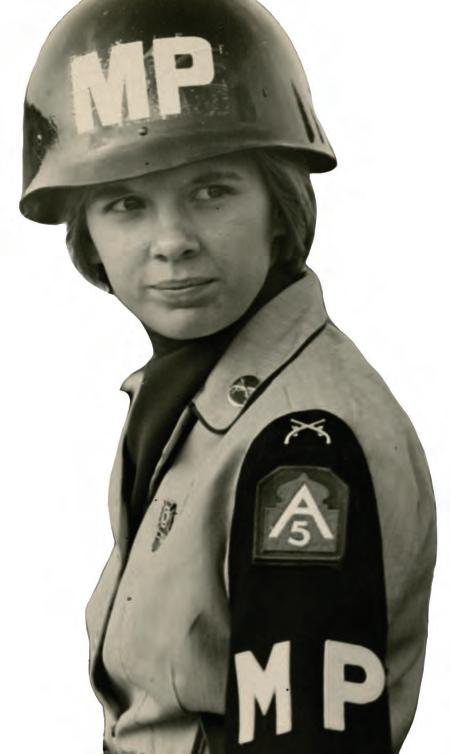
I have told the story many times. Things change; my hormones certainly did. When I was a freshman, a beautiful senior girl passed me in the hall one day. I recall turning and watching her walk down the hallway.
During my high school years, I
worked at the welding shop in the summers but had time to go swimming and enjoy other summertime pleasures.
I co-captained the 1957 Shelbyville High School Red Devils football team, which went undefeated until upended narrowly by the Elizabethtown Panthers in “The Burley Bowl.”
My life really changed just after the season ended. I mustered up the courage to ask Charlotte Frances Rohrer, a beautiful blond senior classmate, for a date. And the rest, as they say, is history. On July 30, we will have been married 63 years and have two children, five grandchildren and three great-grandchildren.
Not a bad life for Snow Hill Bill.
“It was the best of times, it was the worst of times.” Thank you, Mr. Dickens.
I bet some of you folks of my generation and even later had some of the same experiences, didn’t you?
Readers may contact Bill Ellis at editor@ kentuckymonthly.com
• • •
by Gary Garth
The Rod Man
Awhile back, in addition to my work with Kentucky Monthly, I reported on outdoors for The Courier-Journal. One winter afternoon, I was in the downtown Louisville newsroom. This was unusual, as I was rarely in the building, being a remote worker before that became a common thing.
A phone rang. A colleague answered it, then yelled from across the room, “Hey, Garth, it’s for you.”
The caller identified himself as John Durbin. He spoke in a gentle but firm voice, like a man who knew how to make himself understood without being loud or brash. He asked if I was the person who wrote fishing stories for the newspaper. I acknowledged that, yes, I did sometimes write fishing stories for the newspaper.
The winter sport and outdoor show season was approaching, and the caller wanted to contact a show that was held in downtown Louisville. He explained that he built fishing rods and wanted to rent a booth to display some of his rods during the upcoming show. A story with show dates and times recently had appeared in the newspaper, and he was calling to ask if I knew who he might contact about booth space.
It so happened that I did know who to contact and shared the name and phone number. He thanked me and said goodbye, then, an instant before the phone clicked, I asked, “What kind of rods do you build?”
“Bamboo fly rods,” he said.
Even then, bamboo fly rods were antiquated angling relics. They did have a certain gilded romance about them, but, from a performance standpoint, bamboo cannot compete with modern composite rods. I later learned that fans of bamboo fly rods share a curious trait with those of automotive manual-shift transmissions: Not many people want
them, but those who want them don’t want anything else.
I didn’t own a bamboo rod but had fished with one and was smitten. Performance-wise, they are dinosaurs. But aesthetically, they are magnificent—each one beautifully unique as only a wooden, handcrafted fishing tool can be.
We chatted for a few minutes, then John invited me to meet him at his workshop, which was in his garage. I accepted the invite, curious to learn how a butcher from Shively got into the bamboo rod-building business.
• •
•
We met on a frigid, sunny day. John, then recently retired after a 49-year career as a butcher, explained the rod-building process and produced several rods he had built. He handed one to me to try and—not being an expert caster and more accustomed to a fast-action graphite/ composite rod than the slow, deliberate stroke required by bamboo—I made a mess of things, accumulating a pile of tangled fly line at my feet. I spooled up the line with a string of apologies and handed the rod to John. He handed it back. “Try again.” I improved with practice.
John was an unpretentious man, trim and fit, unfailing polite and generally interested in and concerned about others. I ask him how he had become interested in building bamboo fly rods. His answer stunned me. The memory of it still stuns me.
He had been watching a TV show (ABC’s The American Sportsman) about fly fishing. “They were using bamboo rods,” he said. “I thought, ‘Somebody had to make those.’ ”
John visited the library, where he found a copy of A Master’s Guide to Building a Bamboo Fly Rod by Everett Garrison and Hoagy B. Carmichael, originally published in 1977 and still
the authoritative tome on rod building. He studied it, gathered the tools and supplies needed, and taught himself to build a fly rod. I nearly panicked when I learned that the rod I’d been casting was the first one he’d built.
What if I had broken it??
“It’s just a stick,” he said. “I’d make another one.”
John and I became friends and fished together frequently, although not as frequently as either would have preferred. I benefited most from these outings. John was one of the kindest people I’ve ever known—a mentor, teacher and friend. And a fine, totally unselfish fly fisherman.
Health problems eventually slowed him. When I last saw John on a sizzling hot July day last summer, we both knew his fishing days were probably behind him, but—optimistic as anglers are—we made loose plans for a fishing trip when the weather cooled. Until then, he said, he had a gift for me, and with that he handed me a white tube marked with a simple, heartfelt note penned with a Magic Marker. Inside was a 7-foot, 9-inch, 4-weight, 7-piece bamboo rod—a travel rod.
“Let’s see how it casts,” I said quietly.
With the aid of a walker, John moved to the front yard and the stifling heat. I strung up the rod and handed it to him.
“You go first.”
He laid out a few arrow-straight casts, using the same, seemingly effortless, abbreviated left-handed stroke he’d employed in his Shively backyard years earlier. He seemed pleased.
“Well,” I said, “there’s nothing wrong with your casting.”
“No, I guess not.”
Readers may contact Gary Garth at editor@kentuckymonthly.com
field notes 58 KENTUCKY MONTHLY JUNE/JULY 2023









FEBRUARY 2013 • KENTUCKY MONTHLY 59 Compare all options with just one call... AUSTIN TYLER LICENSED INSURANCE REPRESENTATIVE 859.618.6443 ANDREW HORN LICENSED INSURANCE REPRESENTATIVE 859.868.4006 TURNING 65? NEED MEDICARE ENROLLMENT HELP? MEDICARE ADVANTAGE QUESTIONS? 2333 ALEXANDRIA DRIVE, LEXINGTON, KY 40504 TYLERINSURANCEGROUP.COM Questions? We have answers! WE SPECIALIZE IN Medicare Supplement Plans Part D Prescription Plans Medicare Advantage PPO & HMO Plans Dental & Vision Options We do not offer every plan available in your area. Any information we provide is limited to those plans we do offer in your area. Please contact Medicare.gov or 1-800-Medicare to get information on all of your options. Not affiliated with the U.S. Government or Federal Medicare Program. Offering Life Insurance and Medicare www.visitcarrolltonky.com Relax. Camp in one of our campgrounds, Two Rivers Campground or General Butler State Resort Park Hike. Boat. Take in one of our events. Carrollton, the confluence of the Ohio and Kentucky Rivers. Conveniently located between Louisville and Cincinnati on Interstate 71. We’re saving a seat for you! where rivers and people meet... scan to see more
by Walt Reichert
What’s Ailing My Tomatoes?
It’s summertime, and the tomatoes are ripening.
Yes, I know there are four of you out there who have been eating BLTs for the last few weeks. Just know that we don’t like you. Normal people are still waiting patiently.
Tomatoes are by far the most popular vegetable planted in our food patches. Some studies show that they are the most popular plant we grow, period. More than 80 percent of people who do any gardening whatsoever grow at least one tomato plant. That’s probably why, when I worked with Extension, I got more questions about tomatoes this time of year than any other plant. And most of those questions were along the lines of: “What’s ailing my tomatoes?”
Tomatoes belong to the solanaceae family of plants that includes peppers, potatoes, tobacco and several poisonous siblings, notably jimsonweed. As a group, the family is pretty hardy, but as plant breeders sought ever bigger, redder and tastier tomatoes, disease resistance often got lost.
These days, tomatoes are subject to several diseases (and some insect issues) that can limit or entirely eliminate production. I can’t tell you how many times I heard the lament, “I put out 25 tomato plants this year and got, like, two tomatoes.” Not a good return on investment.
It’s probably impossible to eliminate disease in your tomatoes completely, but I’ll offer some tips on knocking back disease so that you get at least four tomatoes this year.
DISEASE RESISTANT
If you know the varieties of tomatoes you planted, make a note this year of which do well and which do not. Then next year, choose the varieties that perform well in your garden. At a minimum, choose varieties that are resistant to fusarium and verticillium wilts. Those varieties will have an F and V after the variety names.
Second, use good cultural practices. Don’t plant tomatoes in the same place every year. Some diseases persist in the soil and will infect the next generation of tomatoes planted there.
Don’t plant tomatoes too close together. Air flow between the plants helps keep disease to a minimum. Also, try not to water tomatoes overhead. Aim the water at the roots, or better still, use drip irrigation. If you must water the plants from above, do so in the morning so the foliage has a chance to dry off before evening.
Finally, at the end of the season, be sure to clean up old plant material, since some diseases overwinter there. Be especially vigilant about getting rid of old tomato, pepper, eggplant and

potato plants, and don’t put them in a compost pile. Burn them or send them out with the garbage. Buying diseaseresistant cultivars and good cultural practices go a long way toward warding off diseases. But sometimes, fungicides are needed. Organic gardeners can use copper as a fungicide. If you don’t go the organic route, you can use products containing maneb (Mancozeb) or chlorothalonil (Daconil or Fungonil).
These products work best as a preventive, much as a vaccine works in a person. The key to using fungicides successfully is not to wait until you see the disease but to spray the plants while they are still apparently healthy. With tomatoes, the best approach I’ve found is to spray once just after the plants have been set in the garden and again about a week later. That seems to keep disease pressure to a minimum.
Always read the label carefully before spraying. Applying too much ingredient, especially copper, is often more harmful than not spraying at all.
SPECIFIC AILMENTS
Early blight and Septoria – These two probably are the most common diseases home gardeners will encounter. They’re characterized by spots on the leaves and dropping of infected leaves. Early blight is soilborne; Septoria resides on old plant tissue. Good cultural practices and rotation help. Spraying with copper or Mancozeb early on also helps. There are few varieties resistant to early
gardening
60 KENTUCKY MONTHLY JUNE/JULY 2023
blight and none, so far as I know, resistant to Septoria.
Blossom end rot – This is another common ailment that usually hits the first tomatoes of the season. The blossom end of the fruit appears leathery and sunken. It’s caused by a lack of calcium uptake. The best defense is a steady supply of water (try mulching) and sufficient supply of calcium. As the temperatures warm, the malady tends to correct itself.
Splitting and cracking – These are not diseases per se but rather cultural issues. Tomatoes commonly split when a dry spell is followed by heavy rain. With their thin skins, heirloom tomatoes seem to be most prone. Again, mulching to keep a steady supply of water helps. Also, some varieties are bred to resist splitting and cracking.
Blossom drop – When temperatures rise above 90 degrees, blossoms will fail to set fruit, so you may experience a lull in production. The only thing to do is wait for cooler temperatures, and fruit production should resume.
CREATURE ATTACK
While tomatoes are prone to several ailments, they typically escape major insect damage. You may have to deal with cutworms that chop down the plant within days of setting in the garden. They are most common in new gardens that were in sod the previous year. You can foil them by putting a cardboard toilet paper tube around the plant after setting out. Once the plant has been in the ground a week or two, the cutworms leave it alone.
Another creature that can almost devour a tomato plant is the hornworm. It’s a large deep green worm that attaches itself to the stem. It’s often overlooked until you see its damage—missing leaves and sometimes chewed-on fruit. There is no need to spray for hornworms. You can pick them off and dispose of them. The “horns” make them look fierce, but they can’t hurt you.
A good BLT is worth the effort.
Readers may contact Walt Reichert at editor@kentuckymonthly.com

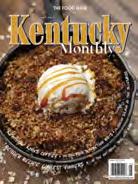
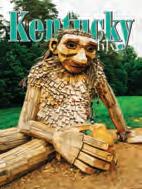







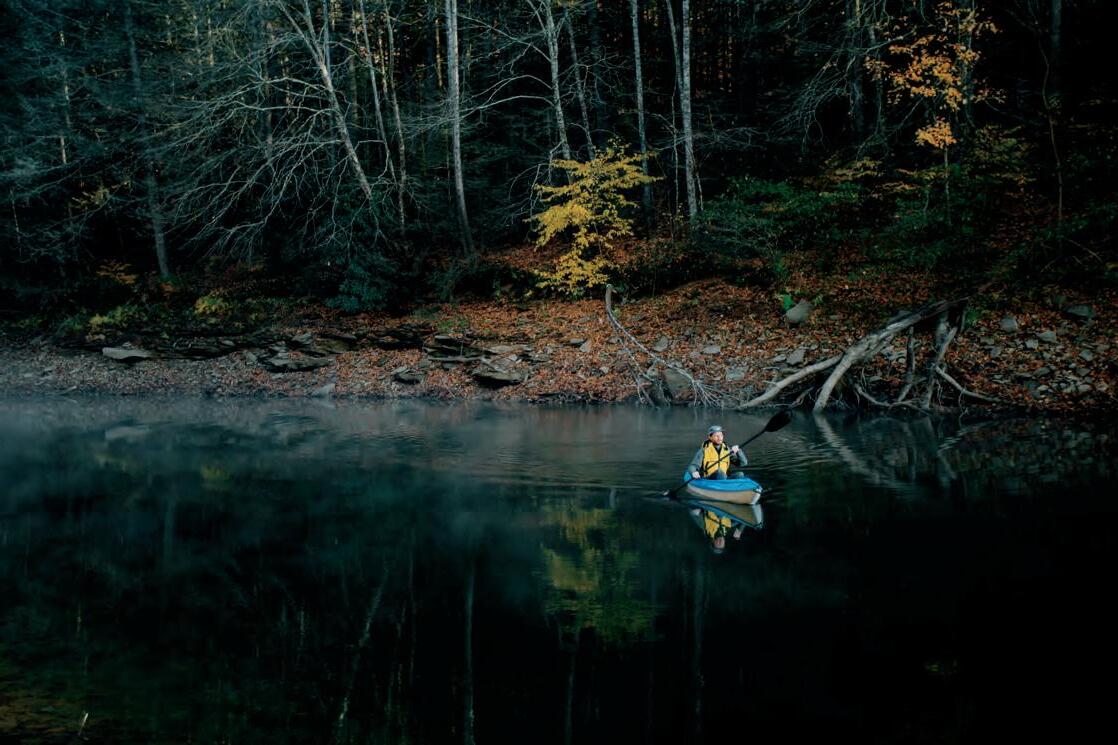
kentuckymonthly.com 61
Whatever your taste for adventure, London, KY is the ideal place to start. Because here, on the edge of the great Appalachia, surrounded by pristine forests, lakes, rivers and amazing history, unforgettable adventures begin right outside our door. VisitLondonKY.com. Adventure’s Beginning!
Fishing Paddling Off-Roading Wakeboarding Camping Motocross Hunting Drag Racing
Choose Your own Adventure.
Kayaking
LAUREL RIVER LAKE
Uniting Kentuckians everywhere. Kentucky Monthly Magazine is your guide to the Commonwealth and the exceptional offerings that make the Bluegrass State such a wonderful place to visit or call home. • GARDENING • EDUCATION • OUTDOORS • • FOOD + RECIPES • TRAVEL + GETAWAYS • • KENTUCKY LIFE + EVENTS • KENTUCKY PEOPLE • SUBSCRIBE: 502.227.0053 OR KENTUCKYMONTHLY.COM #KYMONTHLY First Generation Women Achievers Touring Your Home State Frontier Nursing University Ignite Institute Facts About Kentucky Colleges plus G ia nts of the Fore st Birding in Kentucky Berea Festival of Learnshops Pioneer Playhouse Celebrates 70 Years KENTUCKY DAYTRIPS FOR THE ENTIRE FAMILY plus THE Chrysalis PROJECT Photography benefits need
JUNE 2023
Ongoing Showstopper: Quilts by Marilyn Badger, National Quilt Museum, Paducah, through Aug. 1, 270.442.8856

4 Duncan Hines: A Food Odyssey, Kentucky Museum, Bowling Green, 270.745.2592
11 Blippi: the Wonderful World Tour, Appalachian Wireless Arena, Pikeville, 606.444.5500
18
FATHER’S DAY
Ongoing West of Ninth: Race, Reckoning & Reconciliation, Frazier History Museum, through Sept. 1, Louisville, 502.753.5663
5 Duncan Hines Days, downtown, Bowling Green, through June 11
14
Ongoing Rounding the Circle Exhibit Speed Art Museum, Louisville, through Aug. 6, 502.634.2700
6 All Time Low and Mayday Parade, MegaCorp Pavilion, Newport, 859.900.2294
Ongoing Exhibits: Seeing Now and Pillow Fight, 21C Museum Hotel, Lexington, through Oct. 1, 859.899.6800
7 Castle & Key Springhouse Music Series, Castle & Key Distillery, Frankfort, 502.395.9070
19
20
To Kill a Mockingbird, The Kentucky Center, Louisville, through June 25, 502.584.7777
Stevie Nicks in Concert KFC YUM! Center, Louisville, 502.690.9000 >>>

21 ROMP Fest, Yellow Creek Park, Owensboro, through June 24, 270.926.7891
28
Waterfront Wednesdays, Waterfront Park, Louisville, 502.574.3768
1 Great American Brass Band Festival, Centre College, Danville, through June 4, 859.319.8426
8 Music @BCM, BehringerCrawford Museum, Covington, also June 15, 22 and 29, 859.491.4003
15 Stephen Sharer: Share the Love Music Tour, Lexington Opera House, Lexington, 859.233.4567
22
Michter’s Speakeasy, Frazier Museum, Louisville, 502.753.5663
29
Blackberry Smoke in Concert, Paramount Arts Center, Ashland, 606.324.0007
2 Mortons Gap Coalfield Festival, Mortons Gap, through June 3, 270.258.5362
9 Lu-Ray Arts Festival, downtown Central City, through June 10
16 Beattyville Bourbon & Moonshine Festival, downtown, Beattyville, 606.464.5038
23 Highway 41 Yard Sale, along Highway 41 in Western Kentucky, through June 24, 270.821.4171
30 4th Fest and Praise in the Park, Madisonville City Park, Madisonville, through July 2, 270.824.2100
a guide to Kentucky’s most interesting events
3 Porchfest, downtown Henderson, 270.826.3128
10 Beer Cheese Festival, downtown Winchester, through June 11, 859.744.0556
17 Kentucky Blues Festival, Kentucky Music Hall of Fame, Mount Vernon, 606.256.1000
24 Travis Tritt In Concert, Appalachian Wireless Arena, Pikeville, 606.444.5500

SUNDAY MONDAY TUESDAY WEDNESDAY THURSDAY FRIDAY SATURDAY
calendar 62 KENTUCKY MONTHLY JUNE/JULY 2023
Detail of “Marie's Treasure” quilt by Marilyn Badger
W.C. Handy Blues & Barbecue Festival, Audubon Mills Park, Henderson, through June 17, 270.826.3128 >>>
27

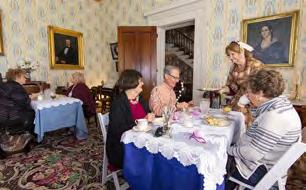

SUNDAY MONDAY TUESDAY WEDNESDAY THURSDAY FRIDAY SATURDAY JULY 2023 2 1 Doobie Brothers in Concert, Louisville Palace, 502.883.5774 6 8 Brothers Osborne in Concert, The Amp at Log Still, Gethsemane, 502.917.0710 9 Jets Over Kentucky, Taylor County Airport, Campbellsville, through July 16, 270.465.3786 10 11 Louisville Orchestra in Harmony Tour, MegaCorp Pavilion, Newport, 502.587.8681 15 Minnie Adkins Day, Little Sandy Lodge, Sandy Hook, 606.738.5515 23 24 25 Kosher Lutherans, Pioneer Playhouse, Danville, through Aug. 12, 859.236.2747 17 3 12 Wild Wednesday Kids Nature Program, John J. Audubon State Park, Henderson, 270.826.2247 13 Master Musicians Festival, SCC, Somerset, through July 15, 606.875.6732 16 Louisville Orchestra in Harmony Tour, Stephen Foster Story, Bardstown, 502.587.8681 26 Sandy Lee Watkins Songwriters Festival, downtown Henderson, 270.826.3128 find more at kentuckymonthly.com 7 Outlaw Diesel Super Series, Beech Bend Raceway, Bowling Green, through July 8, 270.781.7634 14 Picnic in the Park, Old Fort Harrod State Park, Harrodsburg, 859.734.3314 21 Doug Stone in Concert, Mountain Arts Center, Prestonsburg, 606.886.2623 28 kentuckymonthly.com 63 29 Rock the Dam Fest, Beaver Dam Amphitheater, Beaver Dam, 270.298.0036 22 Licking River Paddling Trip, Blue Licks Battlefield State Resort Park, Carlisle, 859.289.5507 30 27 Glier's Goettafest, Newport on the Levee, Newport, through July 30, 859.291.1800 4 FOURTH OF JULY 31 Tea Tuesday, Waveland State Historic Site, Lexington, 859.272.3611 18 >>> 5 Castle & Key Springhouse Music Series, Castle & Key Distillery, Frankfort, 502.395.9070 >>>
Fear and Loathing of AI
Writers are terrified by AI (artificial intelligence), which can write its own stories, paint in the style of the masters, etc. I asked AI to “write a 600word essay linking Denny Crum, Joe B. Hall, Daniel Boone and Simon Kenton in the voice of Hunter S. Thompson” to see how far it’s come. Sports fans will quickly find factual errors, such as Crum and Hall being teammates at the University of Kentucky (the AI must’ve been smokin’ some of Thompson’s dope), but hopefully, you can see why writers, including those striking in Hollywood, are scared. While it should have mentioned Hunter swilling Chivas Regal and Wild Turkey, here is what AI produced:
role in Kentucky’s early history. Kenton and Boone were buds, and Kenton helped Boone escape from a nefarious group of Native Americans who had captured him. These connections make Kentucky unique, showing how our history intertwines with our present, creating a quilt of fascinating and inspiring stories.
STEPHEN M. VEST Publisher + Editor-in-Chief

As I sit in my Kentucky abode, my mind wanders to the great men who have graced this state with their presence. And what a quartet I stumbled upon—Denny Crum, Joe B. Hall, Daniel Boone and Simon Kenton. Four names may appear disjointed, but upon closer inspection, they reveal a web of connections that are uniquely Kentucky. Let’s start with the basketball coaches. Crum, who led Louisville to two national championships, spent his early days playing for Adolph Rupp at UK. As many of you know, Rupp is a basketball legend in his own right, having won four national championships during his storied UK tenure. But his influence on Crum set the stage for the latter’s future successes. And then there’s Hall, who took over from Rupp as the head coach of the Wildcats and led them to a national championship in 1978. Hall was not only a great coach but also a great player, having played alongside Crum at UK. Both influenced by Rupp, these two would leave their indelible marks on the basketball world.
But what about the other two? How do they fit into this story?
Well, let me tell you about Boone, the legendary pioneer known for his Kentucky explorations. You may not know Boone’s great-grandson, J. Winston Coleman Jr., was a UK professor and wrote a book about Boone’s life and legacy. This historical legacy runs deep in Kentucky. Finally, we have Kenton, the frontiersman, and soldier who played a crucial
For fun, I asked AI to build a story about me and writer Ed McClanahan, who died in 2021. In its first attempt, it concocted a tale about us being old friends (true) and how we developed the plan for Kentucky Monthly (false) during an annual fishing trip to Lake Cumberland (not true). I rephrased my request, and its second attempt was more factual, but I became a 2016 Kentucky Journalism Hall of Fame inductee (untrue, unless the invitation was lost in the mail). AI strung together random facts well, but the accuracy was sketchy. A reader unfamiliar with the topic could easily see it as factual.
Here’s what I do know about the Crum, who died at 86 on May 9. In 1986, I worked in the background of UofL’s NCAA Championship run as an intern in the sports information office. I spoke to “Coach” once—maybe twice. “Coach” was Crum, who was at the height of his Hall of Fame career. When Milt Wagner sank two free throws to beat Memphis State in the Metro Conference Championship, my job was to pull cables off the floor so the camera operators wouldn’t trip.
In 2017, 31 years later, 16 years after his retirement and weeks after Crum’s 80th birthday, Tonya York Dees, a college classmate, and I ran into “Coach” in a pre-COVID buffet line. Not only did he call each of us by name, he shared memories of times we crossed paths, including a somewhat cloudy one (on my part) of a tailgate party in the old Cardinal Stadium parking lot.
It’s no wonder his players claim the connections they built with Crum were genuine. To many, he was a second father. He was known as “Cool Hand Luke” for his calm demeanor. To me, he’ll always be “Coach.”
Kwiz Answers: 1. B. Johnny Depp said that in an article in Vanity Fair magazine in 1997; 2. C. Jefferson wrote the Kentucky Resolutions in response to the Alien and Sedition Acts passed by the federal government and judged unconstitutional by Kentucky and Virginia; 3. A. The Ark described in Genesis 6:14-16 is 300 cubits long, 50 cubits wide and 40 cubits high, making it roughly 1.5 football fields long; 4. C. The ERA is derived by calculating how many earned runs a pitcher allows carried over a nine-inning span. Since Sechrist did not record an out, he did not get credit for any portion of an inning pitched, so his ERA literally is incalculable; 5. C. McMullen actually took a pay cut from his 2020 package; 6. B. “Jackson” also has been recorded by the Kingston Trio and Flatt and Scruggs; 7. A., B. and C. Fulton borders Missouri to the west and Tennessee to the south; its largest city, Fulton, has a few more people than its county seat, Hickman; and it borders only Hickman County to the north; 8. B. Fulton County’s Black population is 24.3 percent; 9. A. The 52nd World Championships of Dainty are played on the last Monday in July, as onlookers eating bologna sandwiches watch contestants swing a whittled broomstick at a smaller sharper stick (the dainty); 10. C. Each barrel yields roughly 200 bottles.
vested interest
• • •
• • •
64 KENTUCKY MONTHLY JUNE/JULY 2023

Visit and you’ll discover the only thing ordinary here, is the unexpected.
Conley Bottom Resort, Monticello




EVEN BETTER WITH FRIENDS ArkEncounter.com










































































































 Barbara
Barbara































































































































 By Jackie Young, MLS, Ed.D. Library Director, Sullivan University
By Jackie Young, MLS, Ed.D. Library Director, Sullivan University



 By Terry L. Baldridge, Argillite
By Terry L. Baldridge, Argillite
















































